Spot COMM 1.6/2.4 Transmitter User Manual PN 60 rev 1 indb
Spot LLC 1.6/2.4 Transmitter PN 60 rev 1 indb
Spot >
Spot COMM User's Manual

Table of Contents
Introduction ............................................................................................................4
Using the PN-60 ....................................................................................................6
Using the SPOT Communicator ........................................................................... 13
The Home Page ................................................................................................... 16
The Activities Page .............................................................................................. 17
The Satellites Page .............................................................................................. 18
The Map Page ..................................................................................................... 21
The Compass Page ..............................................................................................32
The Trip Info Page ................................................................................................35
The SPOT Communicator Page ........................................................................... 37
The Find Page ......................................................................................................44
The Waypoints Page ............................................................................................48
The Geocaches Page ...........................................................................................53
The Routes Page ................................................................................................. 61
The Tracks Page ...................................................................................................66

The Prole Page ................................................................................................... 71
The Sun/Moon Page ............................................................................................ 74
The Tides Page .................................................................................................... 76
The Hunt/Fish Page .............................................................................................78
The Settings Page ................................................................................................79
Additional Information ..........................................................................................85
Info Fields Table ...................................................................................................95
Index .................................................................................................................. 101


4
Introduction
This manual is for use with DeLorme Earthmate®
PN-60/PN-60w GPS and SPOT Satellite Communicator
devices. Note References to "PN-60" include both
devices unless otherwise indicated.
Welcome
The Earthmate PN-60/60w is a complete out-of-the-box
handheld GPS solution for all your outdoor activities.
Navigate worry-free with included topo maps of
the U.S. and Canada.
Add high-resolution aerial imagery for a unique
GPS experience.
Enjoy next-generation GPS features and performance.
If you purchased a PN-60w, the addition of a SPOT
Communicator gives you and your loved ones
peace of mind.
Notify the GEOS International Emergency Rescue
Coordination Center of your GPS location.
Send for assistance in time of need—around the world.
Be completely independent of mobile phone or other
land-based radio coverage.
Getting Started
See the Quick Start Guide for detailed information
on setting up your PN-60 and, if included, your SPOT
Communicator.
How to Use the Manual
When the manual instructs you to do something, use
these actions on the PN-60:
To select an item on the screen, such as a eld, check
box, button, drop-down list, menu item, or search
result—use the arrow keypad to move/scroll to
the item to highlight it and press ENTER.
» To edit alphanumeric elds, use the on-screen
keyboard. See Using the Keyboard on page 10.
» To edit numeric elds, use the up/down arrows on
the arrow keypad to increase/decrease numbers
and change other information. Use the left/right
arrows to move the selection.
To clear a selected check box, highlight it and
press ENTER.
When you make a selection or nish editing
information, press ENTER to complete the action.
Introduction

5
Introduction
To exit a page or screen, press QUIT.
To complete a series of steps—an arrow ( > ) indicates
the sequence. Note that the sequences do not include
ENTER and QUIT button presses described above.
Visit the DeLorme Wiki at wiki.delorme.com for more
information. The latest version of the User Manual is always
available for download.

6
Using the PN-60
For information on setting up your device for the rst
time, see the Quick Start Guide.
Batteries and SD Card
Use two AA batteries (Lithium is recommended;
you can also use NiMH or alkaline) or a DeLorme
rechargeable Lithium-ion (Li-ion) battery.
When the PN-60 is using battery power, the battery
indicator on the Home Page displays a lightning bolt.
Remove the batteries when storing the PN-60 for
a month or longer.
A slot for an SD card (not included) is underneath
the batteries inside the battery compartment.
SD/SDHC/MMC cards up to 32GB are supported.
To install batteries and the SD card
1. Unscrew the D-rings on the back of the device
until you can remove the battery cover.
2. Optional. To insert an SD card, gently press down
the SD card latch, insert the card in the slot, and press
down the slot to close the latch. Note Do not lift
the SD card latch as this could cause damage.
3. Insert the batteries according to the polarity symbols
inside the battery compartment.
4. Replace the back cover and screw in the D-rings.
To check the battery type
After you install the batteries, go to Settings > System
> Battery Type and make sure the correct battery type is
selected; this ensures that the battery indicator displays
the correct amount of battery life remaining.
To view the battery indicator
The battery indicator is on the Home Page; for more infor-
mation, see The Home Page section on page 16.
To charge a DeLorme Li-ion battery
in the PN-60
1. Install the battery in the device.
2. To leave the device powered on while charging, power
it on and connect the USB cable to the computer. On
the Home Page, the battery indicator displays a plug.
OR
To put the device in charging mode, power it off,
connect the USB cable to the computer, and then
quickly press Power. The light indicator below the
bottom left corner of the screen ashes red. When
Using the PN-60

7
Using the PN-60
the device is fully charged, the light is green.
To improve battery life
Automatically turn off the backlight after 15 seconds;
go to Settings > Display > Backlight Timer >
15 sec.
Use the power saving option; go to Settings >
System > GPS Setting > Power Saving. For more
information, see To change system settings on
page 79.
Turn off the GPS receiver when inside. Go to Settings
> System > GPS Setting > Off
OR
from the Satellites Page, go to MENU > Turn Off GPS.
Use batteries with higher milliamp-hour (mAh) ratings,
such as Energizer® Ultimate Lithium.
Turning the PN-60 On or Off
The Power button is at the bottom right corner of the
button area.
To turn on the PN-60, press and hold Power until you
see the Welcome screen.
To turn off the PN-60, press Power and hold for
1.5 seconds until the “Shutting down the device”
message displays. Then, release the button.
To view or hide Demo Mode
The rst time you turn on the PN-60, it opens in Demo
Mode.
To view the demo, follow the on-screen instructions.
To exit the demo, press QUIT.
To turn off Demo Mode—from the rst screen, press
ENTER to clear the Show at Startup check box.
To restore Demo Mode, go to Settings > System >
GPS Setting > Demo Mode.
The Home Page
The Home Page uses icons to give you a quick and easy
way to locate the page on the device you want to view.
For more information, see The Home Page section
on page 16.
Rotating the Display
The screen rotates when you turn the device upside down
and the keys on the arrow keypad adjust so that they
match the device’s orientation. If you don’t want the
display to rotate, go to Settings > Display > Allow
Screen Rotation and clear the check box.
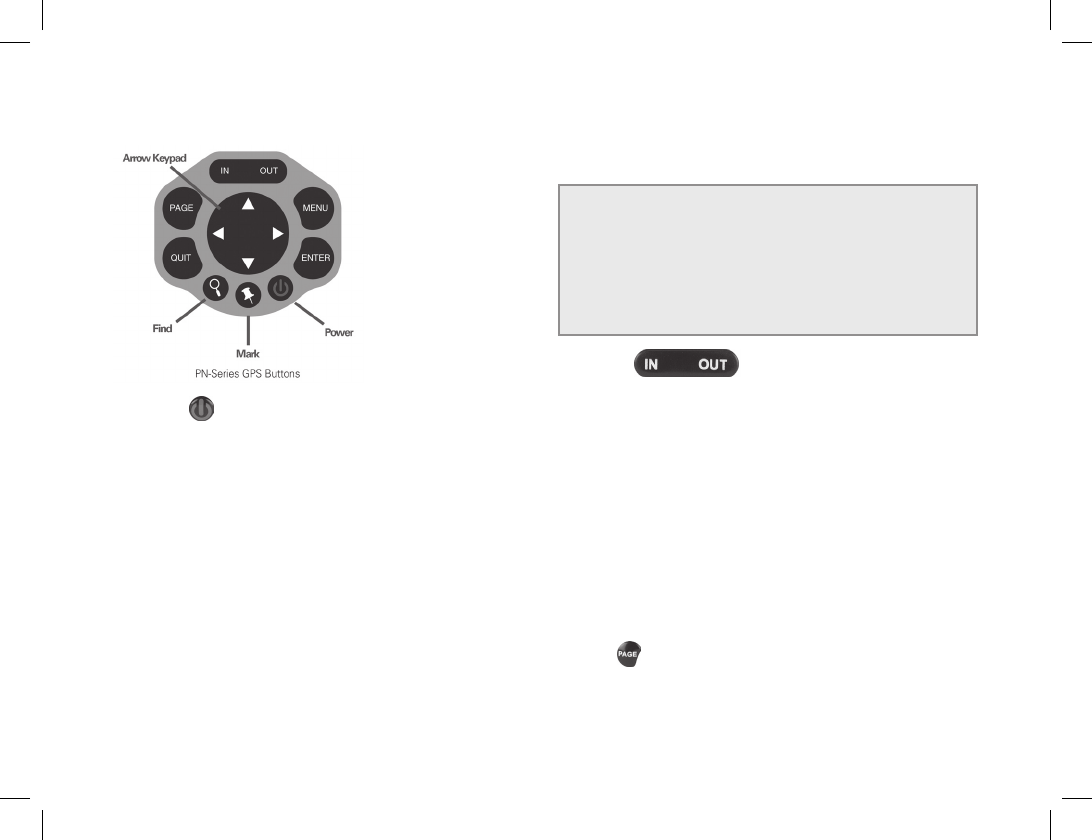
8
Using the Buttons
Power
Use the Power button to turn the PN-60 on and off, lock
the buttons, or to change the backlight settings.
To turn on the device, press and hold the Power
button until the Welcome screen displays.
To turn off the device, press the Power button until
the “Shutting down the device” message displays.
To open the power options screen, quickly press and
release the Power button. The following options are
available:
» To change the backlight intensity, use the arrow
keypad to adjust the backlight slider.
» To lock the buttons, select Yes when you see the
Lock the buttons? message.
» To unlock the buttons, press Power. Then, select
Yes when you see the Unlock the Buttons?
message.
Tips
»Reduce the backlight intensity and decrease the timer to
signicantly improve battery life.
»The TFT screen is readable in direct sunlight or slanting light
conditions.
»For more information about backlight intensity and the back
light timer, see the Settings > Display section on page 80.
In/Out
Use the IN/OUT button to zoom the map or a track prole
in or out or scroll through a list.
Press IN once to zoom the map or a track prole in
one level and show more detail.
Press and hold IN to zoom the map in all the way.
Press OUT once to zoom the map or a track prole
out one level and show less detail.
Press and hold OUT to zoom the map out all the way.
Press IN or OUT to move forward or backward one
page at a time when viewing lists.
Page
Press the PAGE button to move forward through the
pages in the page order sequence. To add, remove, or
Using the PN-60

9
Using the PN-60
reorder pages, go to Settings > Page Order (for more
information, see Page Order on page 84).
The default page sequence is:
Home
Satellites
Map
Compass
Trip Info
Directions (when navigating)
Menu
Press the MENU button to access functions for the page
or screen you are using.
From any page, press the MENU button twice to go
to the Home Page.
From any main menu, press the MENU button to go
to the Home Page.
The menu lists actions specic to the active page—
select the item and press ENTER.
Find
The Find button is labeled with a magnifying glass.
Use it to search your map for a point of interest, address,
coordinates, and more. You can also search for waypoints
and geocaches in an open waypoint or geocache le. For
more information, see The Find Page section starting on
page 44.
Mark
The Mark button is labeled with a pushpin. Use it to mark
a waypoint at your current GPS location or, when panning,
at the cursor location. Once you mark a waypoint, use its
details page to manage it, view it on the map, or create a
route to it. For more information, see The Waypoints Page
section starting on page 48.
Arrow Keypad
Use the arrow keypad to move around pages and screens.
Press once to move the map cursor left, right, up,
or down in increments.
Press and hold to pan the map in that direction.
Highlight options in menus or lists. Press down to
move to the next entry, press up from the rst entry
to go to the last entry, or press down from the last
entry to go to the rst entry.
Highlight elds and highlight characters on the
keyboard screen.
Press and hold to quickly scroll through a menu or list.
On the Map Page, press any arrow once to turn on
the backlight without changing the map view.
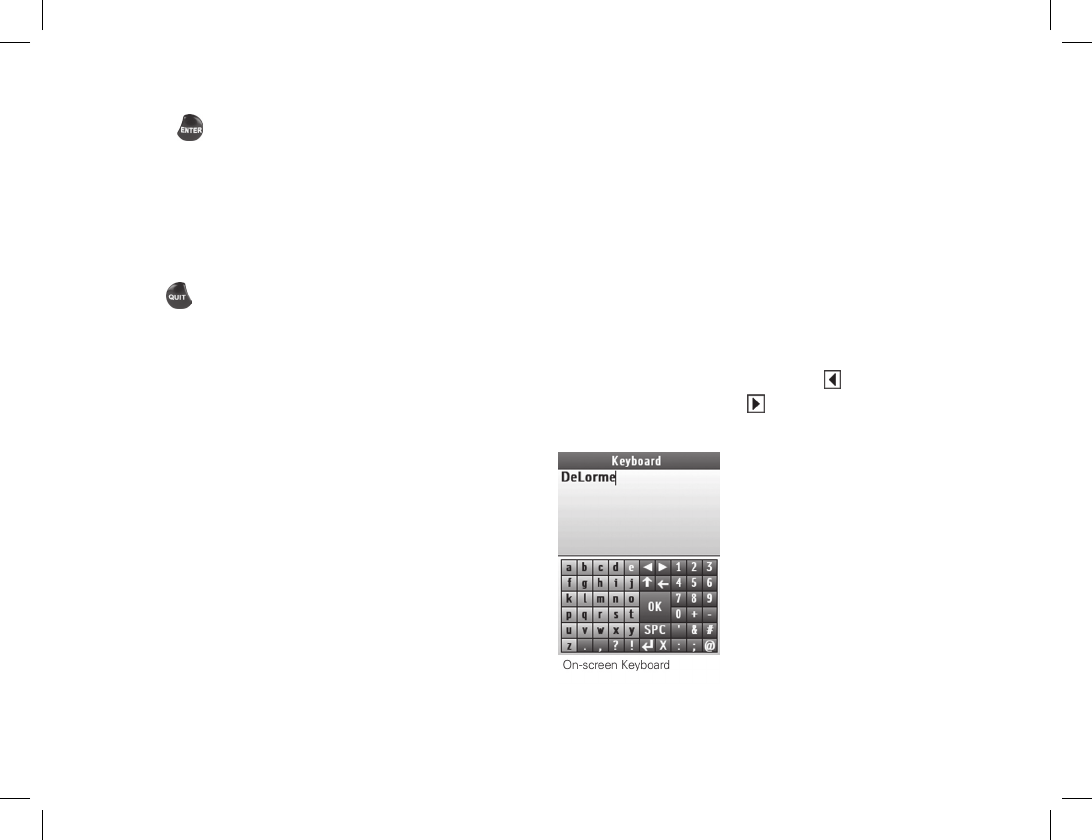
10
Enter
Press the ENTER button to:
Complete the selection of a menu option, entry, eld,
or screen button.
Get detailed information about a point on the map,
if available.
Quit
The function of the QUIT button depends on the status of
the PN-60; some of the things you can do are:
Exit a page or screen.
Cancel actions (for example, panning).
Close the keyboard and cancel changes.
Delete individual points when measuring distance.
Move backwards through the page order sequence.
Taking a Screenshot
To take a screenshot, hold the Power button and
press ENTER.
An SD card must be inserted in the device.
The Screenshots On check box must be selected
in Settings > Display. This creates a “screenshots”
folder on the SD card.
View the SD card contents and open the screenshots
folder. If the SD card is still in the device, go to
Settings > Connect to Computer > Open SD Card.
Using the Keyboard
The on-screen keyboard is available when you need to
enter text, such as when editing a waypoint label, adding
text to a comment eld, or entering search parameters.
Use the arrow keypad to highlight the letter, number,
symbol, or punctuation you want to use, and then press
ENTER after each selection. When you are nished using
the keyboard, highlight OK and press ENTER.
For existing text, enter a letter to replace the highlighted
content. To keep the existing text but move the cursor to
the beginning/end of the text, select to move the
cursor to the beginning or to move the cursor to the
end of the text.
Using the PN-60

11
Using the PN-60
Special Keys
Move the cursor one space to the left without
deleting a letter or number.
Move the cursor one space to the right without
deleting a letter or number.
Change the case of the next letter (the active case
is shown in the keyboard). To use all caps, highlight
and then press ENTER twice.
Move the cursor one space to the left, deleting the
character that was there.
Move the cursor one space to the right, leaving a
blank space.
Clear the content of the text eld being edited.
Accept the changes made to the text eld and
close the keyboard.
Insert a line break and move the cursor to the
next line.
Keyboard Shortcuts
These button presses are keyboard shortcuts.
IN–Delete the last character
OUT–Add a space
Find–Shift (for upper case and to show extra symbols)
Mark–Highlight OK
QUIT–Exit the keyboard
MENU–Move cursor focus from the keyboard to the
text box for faster editing.
Info Fields
The Map, Compass, Trip Info, and Prole Pages include
elds of information that you can customize to suit your
needs. You can even change which info elds display
depending on your activity. For each activity, the info eld
types change for navigating or tracking (regular GPS use).
Tip To change the info elds for an activity navigation/tracking
mode, put the device in that mode before you start making
changes. It is easy to go back to the default settings
at any time.
For more information about what info elds contain, see
the Info Fields Table on page 95.
For more information about Activities, see The Activities
Page on page 17.
To hide or show info elds
On the Map Page, you can hide info elds for a full-screen
view of the map or show them to get information.
Go to MENU > Info Fields and select Hide Info Fields or
Show Info Fields.
To arrange info elds
On the Map Page and Compass Page, you can change

12
how info elds look on the screen.
Go to MENU > Info Fields > Arrange Info Fields and
select an option.
To change the size of the text
On the Trip Info Page, you can change the size of the
text that displays, which also changes the number of info
elds. When the device is set to the small text option,
it displays eight info elds (2 wide, 6 narrow)—when it
is set to the large text option, it displays three wide info
elds.
Press MENU. The available text size option is preceded
by "Switch to"—highlight the option and press ENTER.
To change info elds
On the Map, Compass, Prole, and Trip Info pages,
you can customize which info elds display.
1. From the page, go to MENU > Info Fields > Change
Info Fields.
2. Select the info eld you want to change and press
ENTER. A list of available info elds opens.
3. Select the new info eld and press ENTER.
4. When you nish editing elds, press QUIT. The
changes are saved until you change them again
or restore them to the default settings.
To restore info elds
On the Map, Compass, Prole, and Trip Info Pages, you
can restore the default information elds for your current
activity.
From the page, go to MENU > Info Fields > Restore
Default Info Fields.
Units
You can select the units for different types of measurements
that are used on the PN-60.
To change the units, go to Settings > Units. For more
information, see Units on page 83.
Navigating or Tracking
Tracking is the normal state of the device when it has a
GPS x. You can turn off track recording, but the device
is still in tracking mode. When you follow a route on the
device, you are navigating.
Visit the DeLorme Wiki at wiki.delorme.com for more
information. The latest version of the User Manual is always
available for download.
Using the PN-60

13
Using the SPOT Communicator
The SPOT Satellite Communicator has two buttons and
ve light indicators that provide access to power, the SOS
message, and device status information. It can operate
alone to send emergency messages when the PN-60w
is not available.
For information about setting up the SPOT Communicator
for rst time use and how to set up your account at
ndmespot.com, see the Quick Start Guide.
What You Need to Know
The SPOT Communicator needs a clear view of
the sky to obtain a GPS signal and provide the most
accurate location information. It is not reliable indoors,
in a cave, or in very dense woods.
Orient the SPOT Communicator so that the SPOT
logo faces toward the sky—this provides optimal
performace as the antenna is located under the logo.
Keep the SPOT Communicator at least 12 inches
away from other GPS devices as it can interfere
with signal reception of other GPS devices.
For detailed information about how the SPOT Communicator
works and its coverage area, go to ndmespot.com.
Buttons
Power
The Power button is on the side of the SPOT
Communicator above the SOS button.
Press and hold the Power button for three seconds
to turn the device on and off.
With the SPOT Communicator turned off, press
and hold the Power button for ve seconds to enter
Pairing Mode. Pairing Mode cannot start unless
the device is turned off.
SOS
The SOS button is on the side of the SPOT Satellite
Communicator below the Power button. It has a
protective cover to prevent accidental activation.
To activate or cancel SOS messaging mode from
the the SPOT Communicator, press and hold the SOS
button for three seconds. A message dialog appears
on the PN-60w. An SOS message triggered by the
SPOT Communicator can be canceled by the
Using the SPOT Communicator
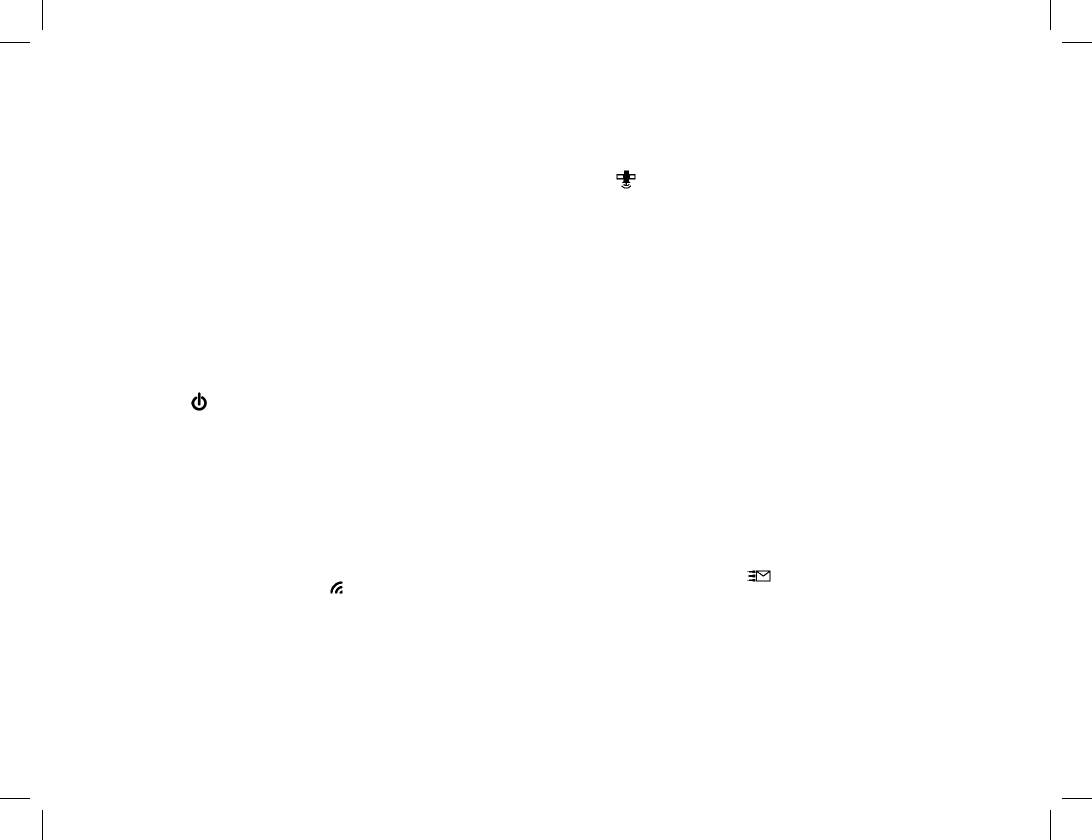
14 Using the SPOT Communicator
SPOT Communicator or by the paired PN-60w.
Note The SOS button should be used only for life-
threatening or other critical situations.
Light Indicators
The SPOT Communicator uses lights to tell you
what it’s doing. Every time you turn the SPOT
Communicator on, it performs an automatic self-test.
Important! If the SPOT Communicator’s self test fails,
the Power, GPS, and Message Sending lights
simultaneously blink red.
Power
The Power light blinks and changes color to indicate
various states:
Green–The SPOT Communicator is on and it passed
the self test.
Red–The batteries have less than 100
transmissions remaining.
Wireless Connection
The Wireless Connection light blinks blue when a
wireless connection is established between the PN-60w
and the SPOT Communicator. The blue light goes off if
the SPOT Communicator has not heard from the PN-60w
in 30 seconds. The Wireless Connection light blinks
rapidly when the PN-60w and SPOT Communicator
are being paired.
GPS
Green–The SPOT Communicator is operating in
independent mode (not connected to the PN-60w),
and is in view of three or more GPS satellites.
Red–The SPOT Communicator is in independent
mode and is unable to see three or more GPS
satellites.
Green/Red–When operating in dependent mode
(connected to the PN-60w), the GPS light blinks
green or red (depending on the GPS acquisition) for
15 seconds when the SPOT Communicator transitions
from GPS acquisition to message transmission.
Note The GPS light blinks green or red (depending
on the GPS acquisition) simultaneously with the
Message Sending light for 15 seconds when the
SPOT Communicator starts sending a SPOT message.
Message Sending
Green–Any SPOT message is being sent.
Red–A casual message was not sent. The casual
message type includes Check-in/OK, Reference Point,
Track Progress, and Geocache messages. For more
information, see page 38.

15
SOS
Green–The SPOT Communicator is in SOS mode.
Red–Cancelling SOS mode.
Batteries and Connector
Batteries
The SPOT Communicator is powered by two Lithium
batteries (Energizer® Ultimate Lithium 8x). See page 92 for
more information.
Connector
The SPOT Communicator has a mini-USB connector
located in the battery compartment. The mini-USB
connector is used to transfer rmware upgrades to
the SPOT Communicator.
Device Pairing
To control the SPOT Communicator with the PN-60w, you
must rst pair the devices. From the Home Page, open
the SPOT Communicator Page and follow the on-screen
instructions. You can also go to Settings > Wireless >
Pair SPOT Communicator to pair the devices.
For more information about device pairing and initial
setup, see the The SPOT Communicator Page section
starting on page 37 and the Quick Start Guide.
Visit the DeLorme Wiki at wiki.delorme.com for more
information. The latest version of the User Manual is always
available for download.
Using the SPOT Communicator
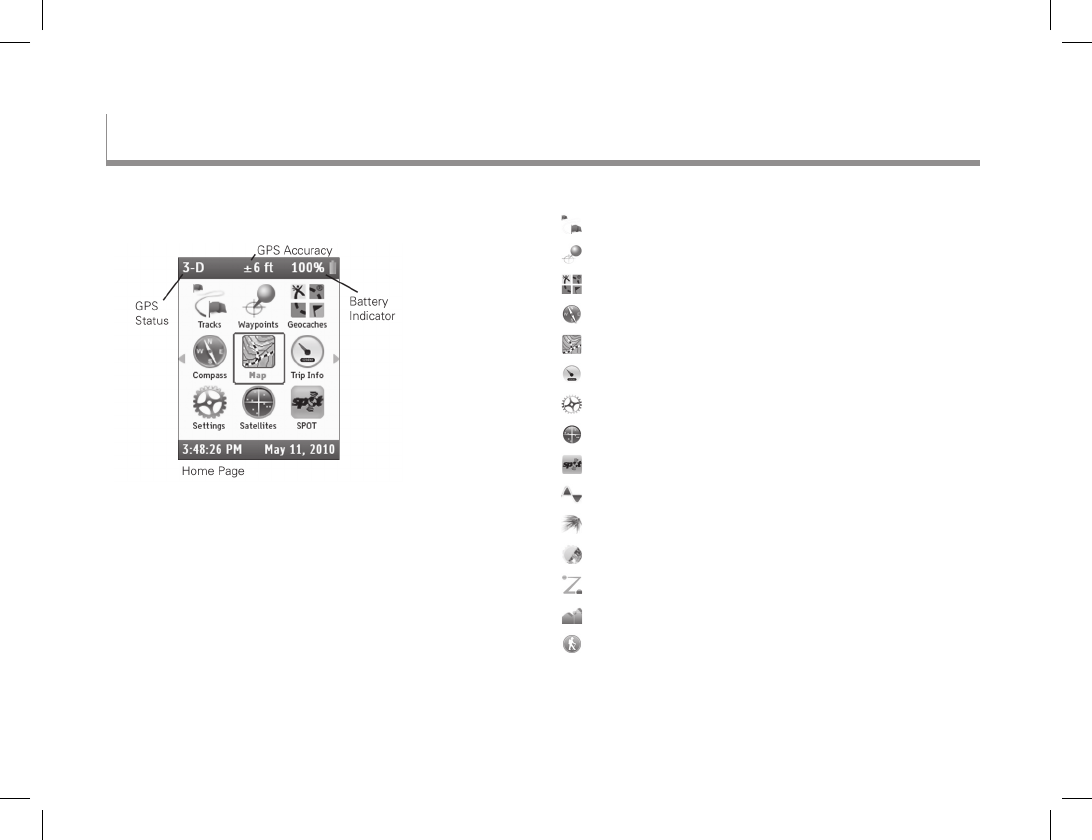
16
The Home Page uses icons to give you a quick and easy
way to locate the page on the device you want to view.
Use the arrow keypad to select an icon and then press
ENTER to open that page. The Home Page also displays
the GPS status and accuracy, the battery indicator, time,
and date.
To quickly get to the Home Page, from any page
on the PN-60, press MENU twice.
To switch pages, press the right or left arrow until
the page view changes.
Home Page Icons
Tracks
Waypoints
Geocaches
Compass
Map
Trip Info
Settings
Satellites
SPOT (PN-60w only)
Tides
Hunt/Fish
Sun/Moon
Routes
Prole
Activities
Visit the DeLorme Wiki at wiki.delorme.com for more
information. The latest version of the User Manual is always
available for download.
The Home Page
The Home Page

17
Use the Activities Page to optimize the info elds and
settings on your PN-60 for eight pre-dened activities
and two custom activities. For each activity, the device
will automatically change the page order, Home Page
icon layout, info elds, and other settings to give you
information that is specic to what you are doing.
If you change an option while you are using an activity,
your changes are saved—allowing you to ne tune each
one of your activities. To change info elds for navigating
or tracking (normal GPS use), just make sure you are in
the mode you want to change.
To change the activity
Select the activity you want to use and press ENTER.
The background of the current activity is highlighted green.
To restore the default activity settings
It's easy to switch back to the default options for an
activity at any time. With the activity you want to reset
highlighted on the Activities Page, go to MENU >
Restore Default Settings.
For more information about the default options for each
activity, visit the DeLorme Wiki (wiki.delorme.com).
To create a custom activity
Highlight one of the Custom activities and then go to
MENU > Rename Button. Use the on-screen keyboard
to edit the button name.
Visit the DeLorme Wiki at wiki.delorme.com for more
information. The latest version of the User Manual is always
available for download.
The Activities Page
The Activities Page
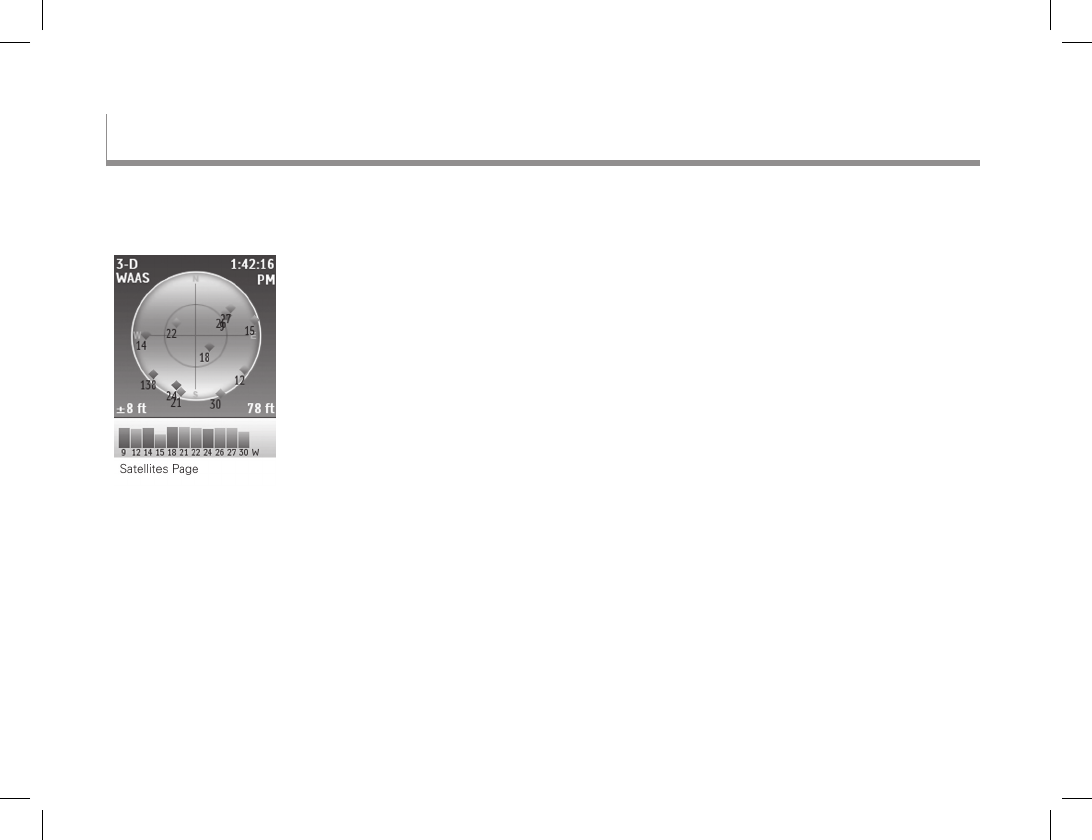
18
The Satellites Page displays GPS and satellite information,
time, and elevation.
Constellation and Signal Graph
Both the satellite constellation and the satellite signal
graph display visible satellites and their identifying numbers.
The satellite constellation depicts each satellite’s position
and the signal graph bars indicate the strength of each
satellite signal.
The icons in the satellite constellation and the bars in the
signal graph are color-coded based on the quality of the
data they are transmitting:
Gray–Satellites have not been located but they are
shown in the constellation because they appear in the
PN-60’s almanac data.
Red–The receiver is tracking the satellite, but it is not
using it to navigate.
Yellow–The receiver is tracking the satellite, predicted
ephemeris data is available when a 3-D x has not
been obtained, and the satellite is being used for
navigation.
Green–The receiver is tracking the satellite,
ephemeris data is available, and the satellite is being
used for navigation.
Blue–The receiver is tracking the satellite, ephemeris
data is available, the satellite is being used for
navigation, and WAAS corrections are available.
GPS and WAAS Status
The Global Positioning System (GPS) is a system of
satellites that orbit the earth to provide position and
navigation information. The Wide Area Augmentation
System (WAAS) is system of satellites and ground
The Satellites Page
The Satellites Page

19
The Satellites Page
stations that correct GPS signals to improve accuracy.
The GPS status is based on the satellite acquisition status.
GPS Off–The GPS receiver is turned off.
No Fix–The GPS does not have sufcient satellite
data to determine your current GPS position.
2-D–The GPS connection is successful, but the
connection quality is not as good as a 3-D x.
Move your receiver to another location to get better
reception.
3-D–The GPS is receiving sufcient satellite data
(horizontal position and elevation) to determine
your location.
When "WAAS" appears below 2-D or 3-D, the PN-60 has
a WAAS connection (available only in North America) that
provides up to ve times greater positional accuracy than
a regular 2-D or 3-D connection.
To set the current location
If it takes a long time for the PN-60 to obtain a 2-D or 3-D
x, verify it has a clear view of the sky. Be sure that trees,
buildings, and other obstacles are not blocking the device.
If the device still cannot obtain a 2-D or 3-D x, go to
MENU > Set Current Location. When the Map Page
displays; pan the map to your current location and
press ENTER.
To turn off GPS
You can use many features on the PN-60 without a GPS
x. When the GPS receiver is turned off, "GPS OFF"
displays on the screen and all satellites are removed
from the satellite constellation.
There are two ways to turn off the GPS receiver.
From the Satellites Page go to MENU > Turn Off
GPS. To turn the GPS on again, go to MENU > Turn
On GPS.
From the Home Page, go to Settings > System >
GPS Setting > GPS Off. To turn the GPS on, select
Normal or Power Saving.
The GPS receiver is temporarily turned off when in
simulation mode (during track playback and navigation
simulation).
Time
You can change the time format, time zone, and manually
set Daylight Saving Time. The time is automatically set
from GPS satellites and is highly accurate.
To change the time settings, from the Home Page,
go to Settings > Time.

20
GPS Accuracy
In the lower left corner of the Satellites Page, the GPS
accuracy displays. This is the calculated accuracy of the
GPS, expressed in distance. The actual location is within
plus or minus the distance indicated of the location
represented by the GPS.
On the Map Page, GPS accuracy is represented by
a circle with a radius equal to the GPS accuracy; your
actual location on the map is within the circle.
Any buildings, natural structures, or heavy foliage that
obstruct the GPS antenna’s view of the sky may prevent
satellite signals from reaching the receiver and decrease
the accuracy of your position. Placing the PN-60 GPS
in a jacket or backpack pocket should not affect
positional accuracy.
Elevation
The elevation is based on the current barometric altimeter
reading. When the Auto Calibrate Altimeter option is
selected, you may see the word “Calibrating” in the
bottom right corner of the screen while the barometer
adjusts—typically 2-3 minutes. If you are using the
Elevation: Barometer info eld on any page, you may
see a red exclamation point in the eld while the
altimeter adjusts.
For more information about calibrating the altimeter,
see Altimeter Calibration on page 87.
Compass and Altimeter
Calibrate the compass and altimeter from the Compass
Page menu or the Satellites Page menu. The Compass
& Altimeter option on the Settings Page has additional
sensor settings. For more information, see Compass
and Altimeter on page 86.
Visit the DeLorme Wiki at wiki.delorme.com for more
information. The latest version of the User Manual is always
available for download.
The Satellites Page

21
The Map Page centers the map on your current location
when the PN-60 has a 2-D or 3-D x. When it does not
have a GPS x, the map displays your last GPS position,
or, if panning the map, the map cursor position. For more
information, see GPS and WAAS Status on page 18.
GPS Arrow
The GPS arrow displays on the map when GPS is turned
on. The color of the GPS arrow depends on your GPS
signal and the arrow points in the direction of the last
known heading.
Flashing Red–The device cannot obtain a GPS signal
and is not tracking satellites.
Blue–The device is in Track Playback mode or
Simulate Navigation mode.
Yellow–The device has a 2-D x. If a 3-D x has
not been obtained, predicted ephemeris is available.
Green–The device has a 3-D x.
Tracking
When tracking satellites, a track line—also known as a
breadcrumb trail—follows the GPS arrow as you move.
If you have turned off track recording, the track does not
appear. For more information, see The Tracks Page
section starting on page 66.
Scale and Orientation
For information about:
Setting the scale, see Scale on page 28.
Map orientation, see Orientation on page 27.
Panning the Map
There are two ways to pan the map. When you pan
the map, the map cursor—a white arrow—shows
your location.
The Map Page
The Map Page

22 The Map Page
Automatic panning–When GPS tracking or
navigating, the map automatically pans in the direction
of travel. The map does not automatically pan when
the map cursor is visible. Press QUIT to remove the
map cursor and return to automatic panning.
Manual panning–To manually pan the map, use the
arrow keypad to move the cursor in the direction you
want to view.
» Use single presses to move the cursor in
increments.
» Press and hold to quickly pan to a new location.
» Hold the cursor at the edge of the screen to keep
panning in that direction; the map will move to the
new location.
» Press QUIT to center the map on your current
location.
As you pan, a text eld at the top of the map displays
information about the cursor location. When you stop the
cursor over an object, the eld in the bottom left corner
displays the object name.
Getting Location Information
For information about objects at your current GPS
location, press ENTER.
OR
Pan the map to a new location. When you stop the cursor
over an object, the object's name is displayed in the
bottom left corner of the map. Press ENTER.
For single objects, the object details page displays.
From this page, you can mark a waypoint, view the
object on the map, or route to the object.
For multiple objects, the Multiple Objects screen
displays a list of the objects at that location;
user-created objects (such as waypoints) appear
at the top of the list. Select an object and then press
ENTER to view its details page.
Info Fields
The Map Page includes elds of information that you can
customize to suit your needs. You can even change which
info elds display depending on your activity. For each
activity, the info eld types change for navigating or

23
tracking (regular GPS use). To access the Info Fields options,
go to MENU > Info Fields. For more information, see Info
Fields on page 11 and The Activities Page on page 17.
Measure Distance
Use the measurement tool to measure the distance of
a line or the perimeter and area of a polygon on the map.
To measure distance
From the Map Page, go to MENU > Measure Distance.
Use the arrow keypad to move the cursor to the area on
the map where you want to place the rst point of the line
or polygon and press ENTER. Repeat for each point.
To undo a point, press QUIT.
To make a polygon, you must close the shape. Place
the last point on top of the rst point by hovering the
cursor over the start location and pressing ENTER to
snap the point and close the polygon.
While you are measuring distance, the pan location infor-
mation that displays in the top right corner of the screen
changes to display the heading from the last measure-
ment node to your current GPS location, the leg distance,
and the total distance from the last measurement node to
the rst measurement node. Once you close a polygon, it
displays the area.
Turn Imagery On/Off
When you have added map packages that include
imagery to your PN-60, you can quickly turn the
imagery off or on.
From the Map Page, go to MENU > Turn Imagery On
or Turn Imagery Off.
Map Setup
Use the Map Setup page to customize the map. You
can change the order of data layers; show or hide maps
and imagery; choose map orientation and scale; and
determine how information displays on the map.
From the Map Page, go to MENU > Map Setup.
The Map Page
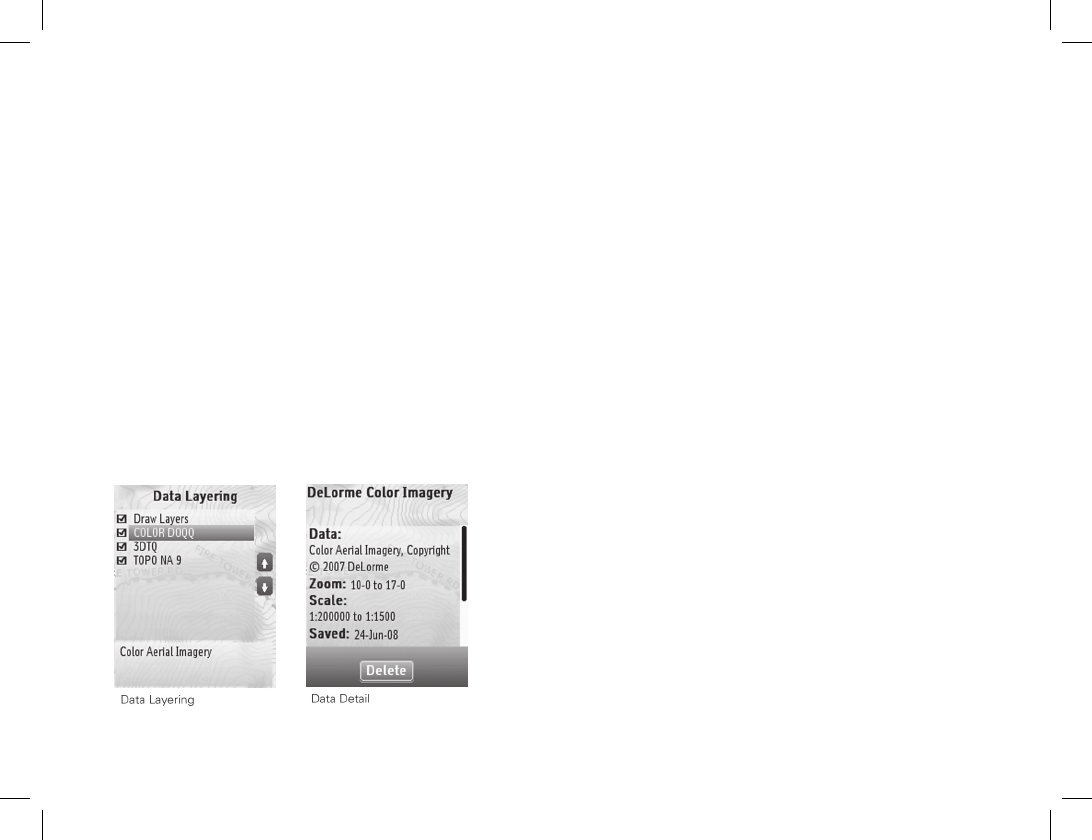
24 The Map Page
Data Layering
The base map that is pre-loaded on the PN-60 shows
high-level world coverage, as well as more detailed
coverage for North America. You can add maps, data,
imagery, draw les, and more to your device to
supplement the base map. When you add different
types of maps to the same area, you can customize
the order in which the layers appear.
For more information about the types of data you can
add to your PN-60, see Detailed Map Data on page 26.
To manage individual map packages that you have added
to your device, see the next section—Data Management.
Only the data types you have on your device show in the
Data Layering list.
The default order for layering data is:
GIS layers by name (XMap® only)
Draw Layers
Public Lands
User Raster Data (XMap only)
Custom Raster Data (XMap only)
ImageReg (XMap only)
High-resolution City Imagery (Hi-Res Cities)
Color Aerial Imagery (Color DOQQ)
Aerial Imagery (DOQQ)
USGS Quads (3DTQ)
Canadian 1:50K Topographic Sheets (Canadian 1:50K)
NOAA Nautical Charts (NOAA Charts)
Satellite Imagery (SAT10)
XMap Topographic Data (XMap only)
DeLorme Topographic Data (Topo North America 9.0)
DeLorme World Base Map 7 (XMap only)
To layer data
Use the Data Layering option to select the types of data
you want to view on your PN-60 and the order in which
you want data to display.
From the Map Page, go to MENU > Map Setup > Data
Layering to view a list of all the types of data you have
stored on your device's internal memory or on an SD card
in the device; this may include data that is not available for

25
the area you are viewing. When you highlight an item, the
full name of the data type shows in the box at the bottom
of the screen.
To show a type of data, select the check box
next to it.
To hide a type of data, clear the check box next to it.
To change the order in which data is layered, highlight
the item you want to move, then use the arrows
on the right side of the screen to move the item up
or down in the list. If two data types have identical
zoom level settings, the one higher in the list has
precedence.
To select/deselect all check boxes, go to MENU >
Select All or MENU > Deselect All.
To reset the default layer settings (all check boxes
selected and data ordered as in the list above), go to
MENU > Restore Layer Defaults.
To view details about the layer, highlight it and go to
MENU > Layer Detail.
Data Management
The PN-60 stores routes and the base map in its internal
memory. You can save user maps—including the detailed
DeLorme Topo North America maps, waypoints,
geocaches, and tracks in the device's internal memory
or on a removable SD card.
To view and manage memory information, go to Settings
> System > Memory Use.
After you add a map—also called a map package or a map
le—from a compatible DeLorme mapping program or
the DeLorme Online Map Center to the PN-60, you can
show or hide it on the device; view details about it,
including where it is stored; or delete it. To change the
priority of how different types of map data are displayed,
see the previous section—Data Layering.
For more information about the types of data you can add
to your PN-60, see the next section, Detailed Map Data.
To manage maps and data
From the Map Page, go to MENU > Map Setup > Data
Management to view a list of the map packages you
have stored in your device's internal memory or on an SD
card in the device. When you highlight an item, the type
of data and location shows at the bottom of the screen.
To show the map package, select the check box
next to it.
To hide the map package, clear the check box
next to it.
To select/deselect all check boxes, go to MENU >
Select All or MENU > Deselect All.
To view the map package on your device, highlight
it and go to MENU > View Map.
The Map Page

26 The Map Page
To view details for a map package, highlight it and
go to MENU > Data Detail. This displays the name,
data types, zoom level, scale information, save date,
location (internal or SD card), and version information.
To delete a map package, highlight it and go to
MENU > Data Detail > Delete.
Detailed Map Data
Your PN-60 comes with a base map showing overview-
level worldwide coverage, as well as North American in-
terstates and routes, state routes, and major roads. While
this provides a great view of a large area, you
need a detailed view of a smaller area for hiking,
geocaching, and other activities.
You can transfer detailed maps and map packages
to the PN-60 using:
PN-Series detailed map DVDs–Included with
your device are DVDs with detailed pre-formatted
DeLorme Topo North America™ data. This data
includes detailed routable road and topographic data
for the U.S. and Canada and major road data for
Mexico. Insert the DVD for your area of interest in
your computer's DVD drive and follow the on-screen
instructions to copy the maps you want onto your
device. Note Elevation data and land cover is not
available for Mexico.
Compatible DeLorme mapping software–
Instructions for sending map packages, data, draw
layers, and more to your PN-60 vary by application.
For more information, see the mapping application’s
Help.
Map Library–Use the NetLink tab in your DeLorme
mapping software or the DeLorme Online Map
Center (data.delorme.com) to download many types
of imagery and data, such as satellite imagery, aerial
imagery, USGS 1:24K Topo Quad maps, Canadian
1:50K topographic sheets, NOAA nautical charts,
and more. With an annual Map Library subscription,
you can download unlimited imagery and data for
the entire year—the maps are yours to keep.
Non-DeLorme maps–DeLorme’s professional
GIS software, XMap®, allows you to register
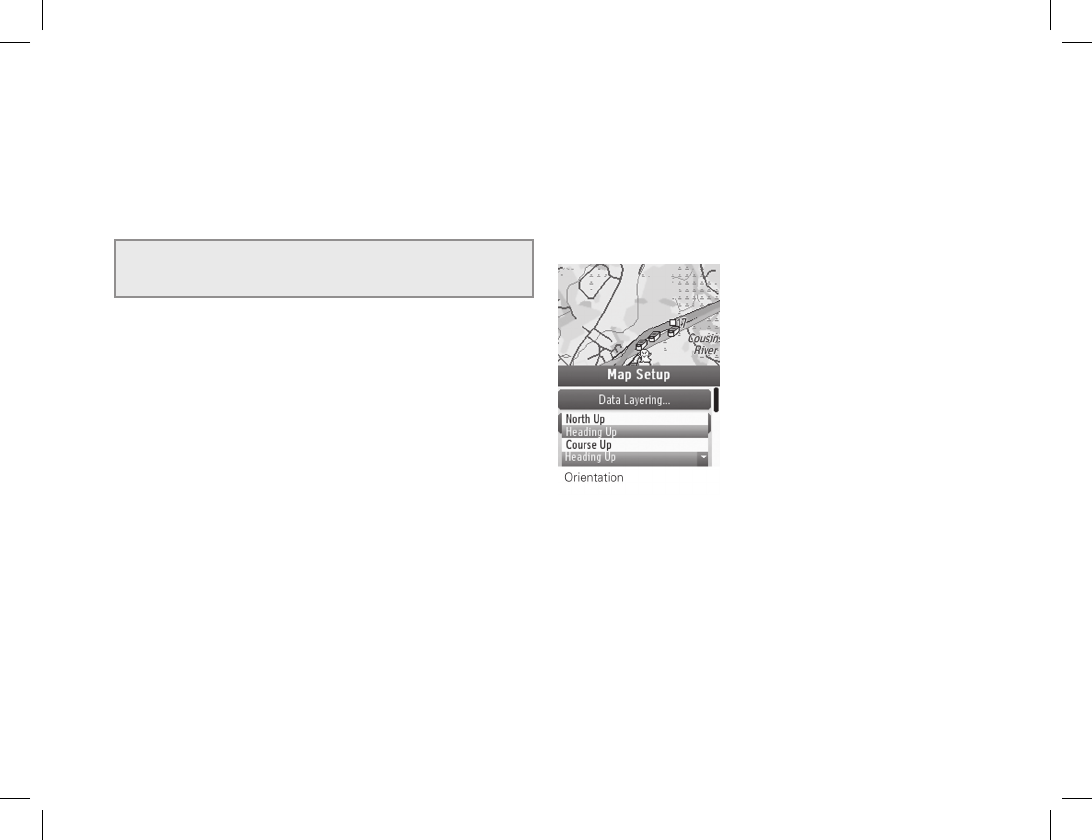
27
non-DeLorme maps and transfer them to a PN-60.
Navionics lake maps and marine charts—Add
shing maps and boating maps and charts to your
device with Navionics SD cards. For more information,
see Navionics on page 29.
Tip A map package is a dataset you create for an area of
interest that you can layer with DeLorme map data and other
map datasets available from the NetLink Map Library.
Map Setup Options
Orientation
You can set the map to rotate as you move.
To change the map orientation
From the Map Page, go to MENU > Map Setup >
Orientation and select the map orientation from
the drop-down list.
North Up–North is always at the top of the
map screen.
Heading Up–The direction in which you are traveling
is always at the top of the map screen. The North
Arrow displays in the top right corner of the
map screen.
Course Up–The direction of the nish of your route
is always at the top of the map screen. The North
Arrow displays in the top right corner of the map
screen when navigating.
If you want Heading Up or Course Up to automatically
switch to North Up above the specied scale (depends
on the units of measure you have set), select the
North Up above... scale check box.
Map Style
Topo View displays all topographic data as it was saved
in the map package; this is the default view. Street View
hides the contours and land cover for a clean road map
that is easier to view when driving.
To change the map style, from the Map Page go to
MENU > Map Setup > Map Style and select Topo View
or Street View from the drop-down list.
The Map Page

28 The Map Page
Hybrid Map
Select the Show Hybrid Map check box to show points,
lines, and labels on top of imagery. Hybrid maps are
visible at scales of 640 feet and higher.
From the Map Page, go to MENU > Map Setup >
Show Hybrid Map.
Map Point Management
You can customize how points of interest (POIs),
waypoints, and geocaches display on the map.
From the Map Page, go to MENU > Map Setup > Map
Point Management. Select each option and then select
how you want that type of map point to appear on the
map. Select the Hide Logged Caches check box if you
do not want logged geocaches to appear on the map.
Scale
Use the scale option to set the type of scale you want
to use on your maps.
To set the scale
From the Map Page, go to MENU > Map Setup > Scale;
from the drop-down list, select an option.
Bar–Represents a given length on the map compared
to an actual length.
Zoom–The DeLorme term for map detail level. Each
time the zoom level increases, the scale doubles.
Ratio–Shows a ratio of a unit on the device compared
to the actual unit.

29
Other Map Menu Options
When navigating or viewing a route on the map, additional
options are available on the Map Page menu.
View Comment Details
When navigating, go to MENU > View Comment
Details to quickly view the comment for the waypoint
or geocache you are navigating to. The comment for the
most recently viewed point is displayed.
Log Your Geocache Find
When navigating to a geocache, use the Log Your
Geocache Find option to quickly log geocaches, write
eld notes, and pick your next cache. For more information
about all of these features, see The Geocaches Page
section starting on page 53.
Route Options
When navigating, use Route Options to stop navigating,
get back on track, or switch the route type. For more
information about route options, see Route Settings
on page 61.
Go to MENU > Route Options and select Stop
Navigating, Back on Track, or Switch to Hiking/
Switch to Driving (the option you can switch to displays).
Hide Route
When you are viewing a route on the map (but not
navigating), you can hide it. Go to MENU > Hide Route.
Navionics
You can use Navionics® HotMaps Premium Lake Maps
and GOLD+ Marine Charts with your PN-60. The charts
are available on SD cards that you insert into your devices.
For more information about the charts that are available,
visit www.navionics.com.
General Information
Navionics information appears on the device only
when you have a Navionics SD card in your device.
You cannot save maps or data to a Navionics SD
card—the memory on the card is unavailable.
The Navionics data overlays the DeLorme maps on
device—the DeLorme maps are used for routing
and Find.
Tracks, routes, waypoints, and geocaches display
over the Navionics charts.
When you pan the map and select an object
(other than those listed above) with the map cursor,
Navionics information is displayed.
The Map Page

30 The Map Page
Turn Charts On/Off
You can quickly turn Navionics charts on or off. The
Navionics chart closest to the map center automatically
displays; if it doesn't, select it from the Chart list on the
Navionics Setup page.
From the Map Page, go to MENU > Turn Charts On
or Turn Charts Off.
Note This menu option controls the Show Charts
and Show Boundaries check boxes on the Navionics
Setup page.
Navionics Setup
Customize the way Navionics charts appear on your
PN-60. To access all of these options, go to MENU >
Map Setup > Navionics Setup.
To select a chart
From the Navionics Setup page, select the chart or map
you want to use from the Chart drop-down list.
To view a chart or map
To view the chart or map selected in the Chart
drop-down list on the device, click View Chart.
To show charts or boundaries
Control how you view charts and their boundaries
on the map—view charts alone, boundaries alone,
or both together.
To show charts, select the Show Charts check box.
To show boundaries, select the Show Boundaries
check box.
To hide charts by map scale
You can customize at which map scale you can view
charts on the device. From the Hide Charts check box,
select the scale above which you want to hide the charts.
To set chart details
To change the detail level of your charts, select High
or Low from the Chart Details drop-down list.
To show or hide contours
You can show all contours or select a level above which
to view them. From the Hide Contours drop-down list,
select the option you want to use.
To set the safety depth
From the Safety Depth drop-down list, select the
option you want to use or turn it off.
To set the presentation mode
US and International charts have different symbols and
markings. From the Presentation Mode drop-down list,
select US or International.

31
To show the depth in fathoms
If you want to show chart depths in fathoms instead
of feet or meters, select the Show Depth in Fathoms
check box.
To restore the default settings
To restore the default Navionics Setup settings, select
Restore Default Settings.
Visit the DeLorme Wiki at wiki.delorme.com for more
information. The latest version of the User Manual is always
available for download.
The Map Page
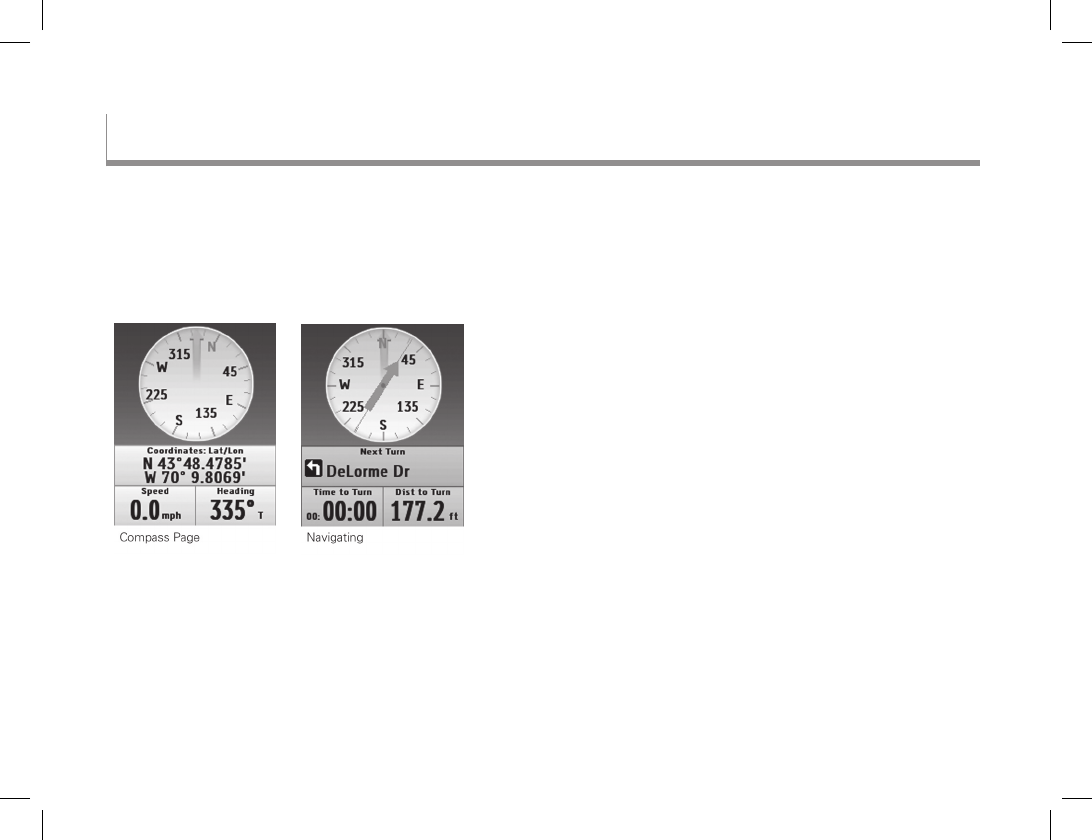
32
Use the Compass Page’s graphic compass to help you
nd your destination. The PN-60 uses GPS to determine
compass readings when the device is moving. It also
has an electronic compass for use when the device is
stationary or moving below 1.5 mph.
Bearing Arrow
As you move, the compass rotates so that the heading
is always up. When you are navigating a route, the green
bearing arrow displays on the compass to show you the
direction you should be going.
To change the Hiking Route Arrow
When you are navigating a hiking (direct) route, you
can choose to have the bearing arrow point to the next
waypoint in your route or point back on course if you
leave the route.
To set the hiking route arrow method; from the Routes
Page, go to MENU > Edit Route Settings > Compass
Navigation Arrow.
To change the hiking route arrow from the Compass Page,
press MENU > Compass Navigation Arrow > Direct
to Next Waypoint or Back on Course.
Electronic Compass
The PN-60’s electronic compass shows your direction
when you are stationary or almost motionless. When your
speed is 1.5 mph or higher, the compass reading is based
on your GPS location information.
When the electronic compass reading is not accurate,
“Poor Accuracy” displays in the bottom right corner of
the screen, and a red exclamation point appears in the
Heading info eld. When you see this indicator, you may
The Compass Page
The Compass Page

33
The Compass Page
want to calibrate the compass unless you know the
inaccuracy is caused by a temporary event, such as being
near power lines or near a magnetic eld caused by a car.
You may want to turn off the electronic compass when
you are in an area with magnetic interference. For more
information, see Compass and Altimeter on page 86.
Tip Calibrate the compass when you change the batteries
in the PN-60.
Calibrating Sensors
You can calibrate the PN-60's electronic compass and
barometric altimeter with the Calibrate option on the
Satellite Page menu, the Compass Page menu, and the
Settings > Compass & Altimeter menu. The Settings
> Compass & Altimeter options allow you to turn the
electronic compass, the barometric altimeter, and
the auto-calibrate altimeter option on or off. For more
information, see Compass and Altimeter on page 86.
Info Fields
The Compass Page includes elds of information that you
can customize to suit your needs. You can even change
which info elds display depending on your activity. For
each activity, the info eld types change for navigating
or tracking (regular GPS use).
To access the Info Fields options, go to MENU > Info
Fields. For more information, see Info Fields on page 11
and The Activities Page section on page 17.
Other Menu Options
When navigating, additional options are available on
the Compass Page menu.
View Comment Details
When navigating to a waypoint or geocache, the View
Comment Details option allows you to view the comment
for the waypoint or geocache. If you view another
waypoint or geocache, View Comment Details displays
the most recent comment details viewed.
Go to MENU > View Comment Details.
Log Your Geocache Find
When navigating to a geocache, use the Log Your
Geocache Find option to quickly log geocaches, write
eld notes, and pick your next cache. For more
information about all of these features, see The
Geocaches Page section starting on page 53.
Route Options
When navigating, use Route Options to stop navigating,

34
get back on track, or switch the route type. For more
information about route options, see Route Settings
on page 61.
Go to MENU > Route Options and select
Stop Navigating, Back on Track, or Switch to
Hiking/Driving (the option you can switch to displays).
Visit the DeLorme Wiki at wiki.delorme.com for more
information. The latest version of the User Manual is always
available for download.
The Compass Page
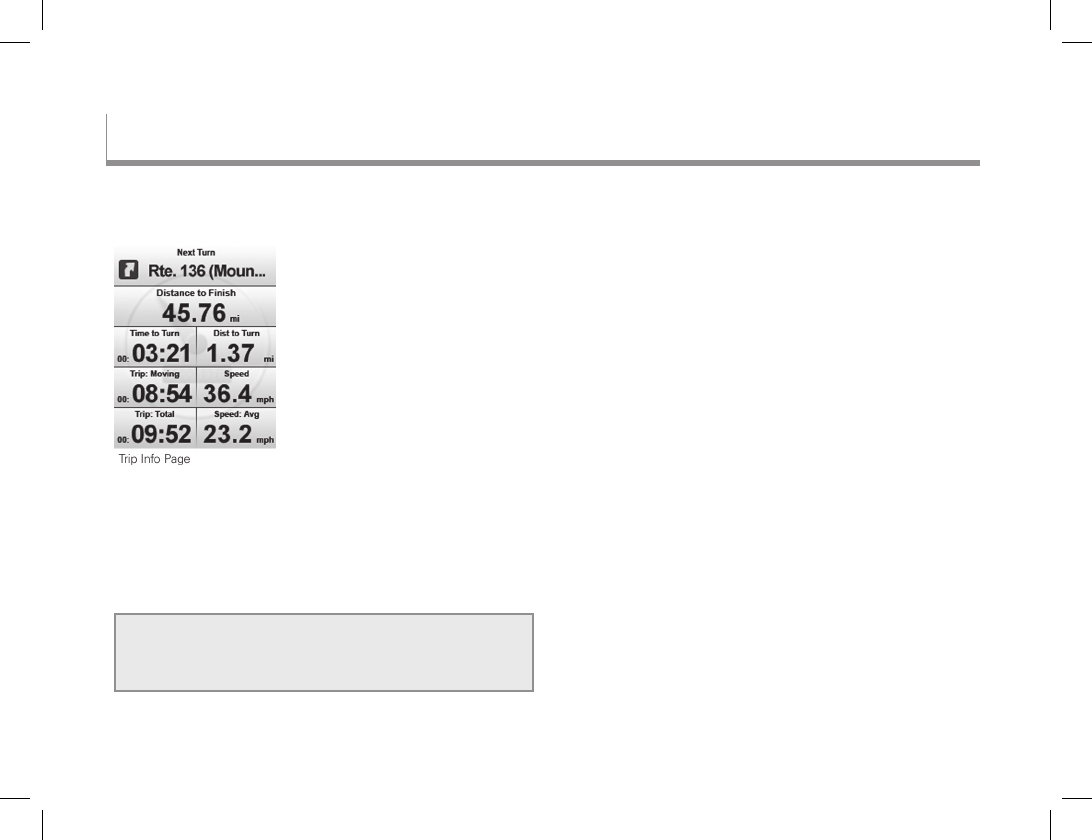
35
The Trip Info Page displays info elds that you can
customize to manage your trips.
Info Fields
You can change which info elds display depending on
your activity. For each activity, the info eld types change
for navigating or tracking (regular GPS use).
Tip To change the info elds for an activity and navigation/
tracking mode, put the device in that mode before you start
making changes. It is easy to go back to the default settings
at any time.
For more information about what info elds contain,
see the Info Fields Table on page 95.
For more information about activities, see The Activities
Page on page 17.
To reset the trip information
Use the Reset Trip Info option to reset the trip values,
speed information, elevation, and the device odometer.
Track recording is not reset. If you want to keep track
of all your travels on your device, clear the Device
Odometer check box before you reset your information.
From the Trip Info Page, go to MENU > Reset Info. To
reset an option, select the check box next to it. To exclude
an option from being reset, clear the check box next to it.
Then, select Reset Now.
Other Menu Options
Additional options are available on the Trip Info Page
menu when you are navigating.
View Comment Details
When navigating to a waypoint or geocache, the View
Comment Details option allows you to view any available
The Trip Info Page
The Trip Info Page

36 The Trip Info Page
comments for the point you are navigating to. The
comments for the most recently viewed point display.
Log Your Geocache Find
When navigating to a geocache, use the Log Your
Geocache Find option to quickly log geocaches, write
eld notes, and pick your next cache. For more
information about all of these features, see The
Geocaches Page section starting on page 53.
Route Options
When navigating, use Route Options to stop navigating,
get back on track, or switch the route type. For more
information about route options, see Route Settings
on page 61.
Visit the DeLorme Wiki at wiki.delorme.com for more
information. The latest version of the User Manual is
always available for download.
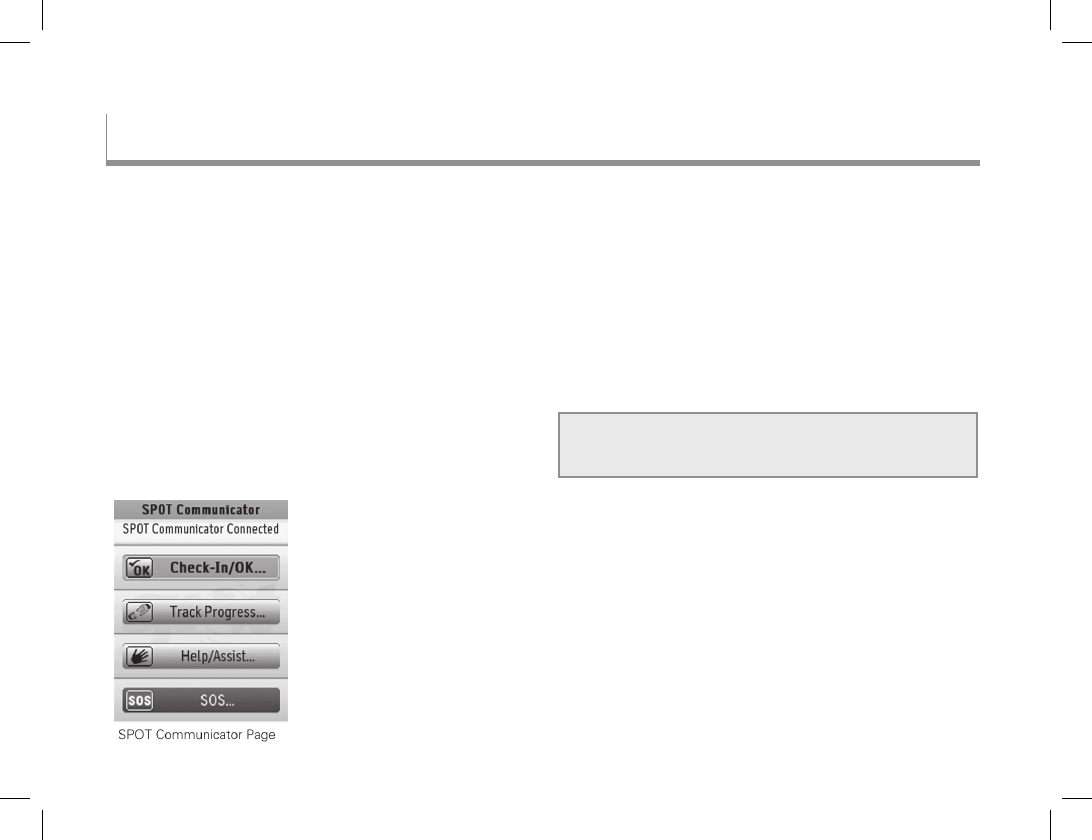
37
PN-60w only
The SPOT Satellite Communicator uses GPS signals and
communication satellites to relay your message—no cell
phone coverage necessary—giving you peace of mind.
The SPOT Communicator Page on the PN-60w gives you
an easy way to use and manage your SPOT Communicator.
See the Quick Start Guide for information about:
» Activating your SPOT account at ndmespot.com
» Setting up your SPOT Communicator for rst-time use
» Pairing your PN-60w and SPOT Communicator
See Using the SPOT Communicator section starting
on page 13 for information about using the device.
Connect
To connect a SPOT Communicator that is paired with the
PN-60w or to initiate the pairing process, go to MENU >
Connect SPOT Communicator.
To disconnect a paired device, go to MENU > Disconnect
SPOT Communicator.
At the top of the SPOT Communicator Page, a message
displays the current status of the SPOT Communicator.
Tip If you need to turn the wireless antenna off, go to
Settings > Wireless and clear the Wireless Antenna On
check box.
Sending Messages
Your SPOT account at ndmespot.com is the link
between your PN-60w and your SPOT Communicator.
When you set up your account, you will add your contacts
and create groups of contacts; write pre-dened
messages to quickly update your status when you're out
in the eld; and send the information to your PN-60w. You
can also purchase additional recommended service op-
tions, such as support for Track Progress and Type
& Send messages.
The SPOT Communicator Page
The SPOT Communicator Page

38 The SPOT Communicator Page
Message Priority Levels
Each type of message you can send is assigned a priority
so that if you have multiple messages to send, each one
is sent in order of importance.
Critical–An SOS message is the highest priority
message type and is sent to the GEOS Rescue
Coordination Center for emergency response. A
critical message supersedes both casual and urgent
messages.
Urgent–Help/Assist messages are the second
highest priority message types. Help messages are
sent to one of the contact groups that you can select
on the PN-60w. Assist messages are sent to one or
more professional service providers for non-critical
emergency response. An urgent message supersedes
a casual message.
Casual–Check-in/OK, Reference Point (marking
a waypoint), or Geocache messages are sent to a
contact or social network that you have set up in your
SPOT account. Track Progress messages are sent
to your SPOT account for logging or to online maps.
A casual message has the least priority.
Message Types
You can send a pre-dened message or you can create
a new text message (Type & Send) and send it to the
contact groups you have set up with your SPOT account.
You can even share with social network websites—
Facebook®, Twitter™, or Fire Eagle™—that you’ve set
up a connection to on ndmespot.com. In addition, SPOT
Adventures (spotadventures.com) provides a location for
you to share your SPOT messages, tracks, videos, and
photos as well as notes from your adventures.
For each message sent, a waypoint icon is placed
on the Map Page.
SOS
Use the SOS message to notify emergency services
of your GPS location and that you need assistance when
you have a life threatening or other critical emergency.
Send a pre-dened message or create a new Type
& Send message.
SOS messages are sent using the critical priority level.
If a GPS x is obtained, an SOS message with the
GPS position will be sent every ve minutes. If there
is no GPS acquisition, the SPOT Communicator
will send your message without coordinates while

39
continually trying to obtain a GPS x.
If the PN-60w loses communication with the SPOT
Communicator, the SPOT Communicator will continue
to send messages using its own GPS every ve
minutes until the PN-60w is turned on and a new
command is issued or the SPOT Communicator
batteries are depleted.
As a backup, the SPOT Communicator can send
SOS messages; simply hold the SOS button on the
side of the SPOT Communicator for three seconds.
You can send an SOS message while in any other
mode, but sending an SOS message cancels any
modes in progress. SOS and Help/Assist messages
can be sent at the same time.
Help/Assist
A Help message noties your contacts that you need
assistance in a non life-threatening situation.
A SPOT Assist message noties SPOT Assist dispatch
centers of your GPS location and that you need assistance.
Professional service providers will be notied that you
need help (SPOT Assist service subscription required).
Send a pre-dened message or create a new Type
& Send message.
Help/Assist messages are sent using the urgent
priority level.
If a GPS x is obtained, a Help or SPOT Assist
message with the GPS position will be sent every
ve minutes for one hour. If the PN-60w loses
communication, the SPOT Communicator will
continue to send messages every ve minutes until
the PN-60w is turned on and a new command is
issued, the one hour timer expires, or the SPOT
Communicator batteries are depleted, whichever
happens rst..
You can send a Help/Assist message while in
Check-in/OK, Track Progress, or SOS modes,
but sending a Help/Assist message cancels any
Check-in/OK or Track Progress messages that are
in progress. Help/Assist and SOS messages can
be sent at the same time.
Check-in/OK
Send a message to your contacts or upload eld notes
to Geocaching.com.
Send a pre-dened message or create a new Type
& Send message.
Check-in/OK messages are sent using the casual
priority level.
If a GPS x is obtained, the Check-in/OK message will
be sent three times within a 20 minute window.
Important To increase the probability of a successful
The SPOT Communicator Page
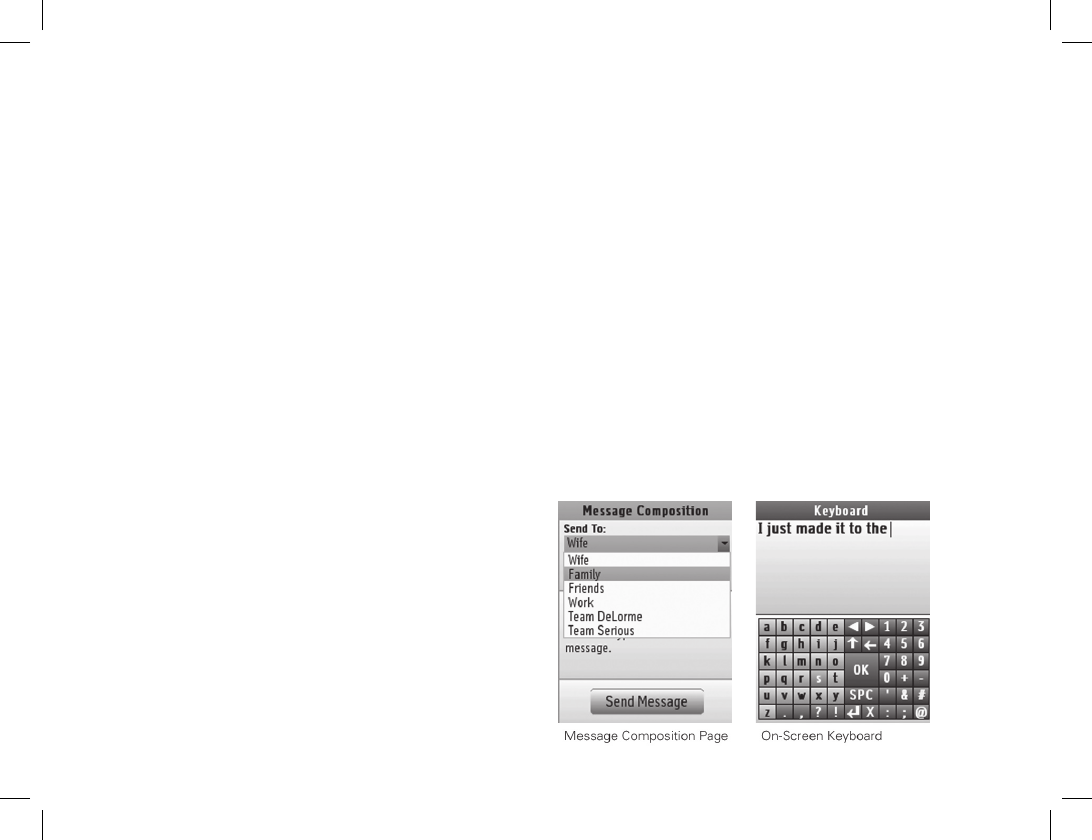
40 The SPOT Communicator Page
message transmission from the eld and out to
contact lists, allow your SPOT Communicator to
transmit until the message cycle is complete.
You can send a Check-in/OK message while a Track
Progress message in in progress, but it will interrupt
the Track Progress messages until the Check-in/OK
message cycle is complete.
You cannot send a Check-in/OK message when
an SOS or Help/Assist message is in progress.
Track Progress (Optional Service)
A Track Progress message sends your location to your SPOT
account (My Account at ndmespot.com). You also have the
option to share your location data in near real-time via web
links to a Shared Page or a Live Map at spotadventures.com.
Track Progress messages are sent using the casual
priority level.
If a GPS x is obtained, a Track Progress message will be
sent every 10 minutes for 24 hours unless canceled.
You cannot send this type of message when an
SOS or Help/Assist message is in progress.
To send a message
1. From the SPOT Communicator Page, select the
message type: Check-in/OK, Track Progress,
Help/Assist, or SOS.
2. On the Message Composition page, select
the contact, group, or Social Networks Only from
the Send drop-down list,
3. If you selected Social Networks Only, select the check
box for the site you want to post a message to.
4. From the Message drop-down list, select the
message type; you can send a pre-dened message
or a Type & Send message.
5. If you selected Type & Send message, use the arrow
keypad to highlight the text area and press ENTER
to open the on-screen keyboard. As you enter your
message, note that the remaining number of
characters allowed displays. When you nish typing
the message, select OK.
6. On the Message Composition page,
select Send Message.
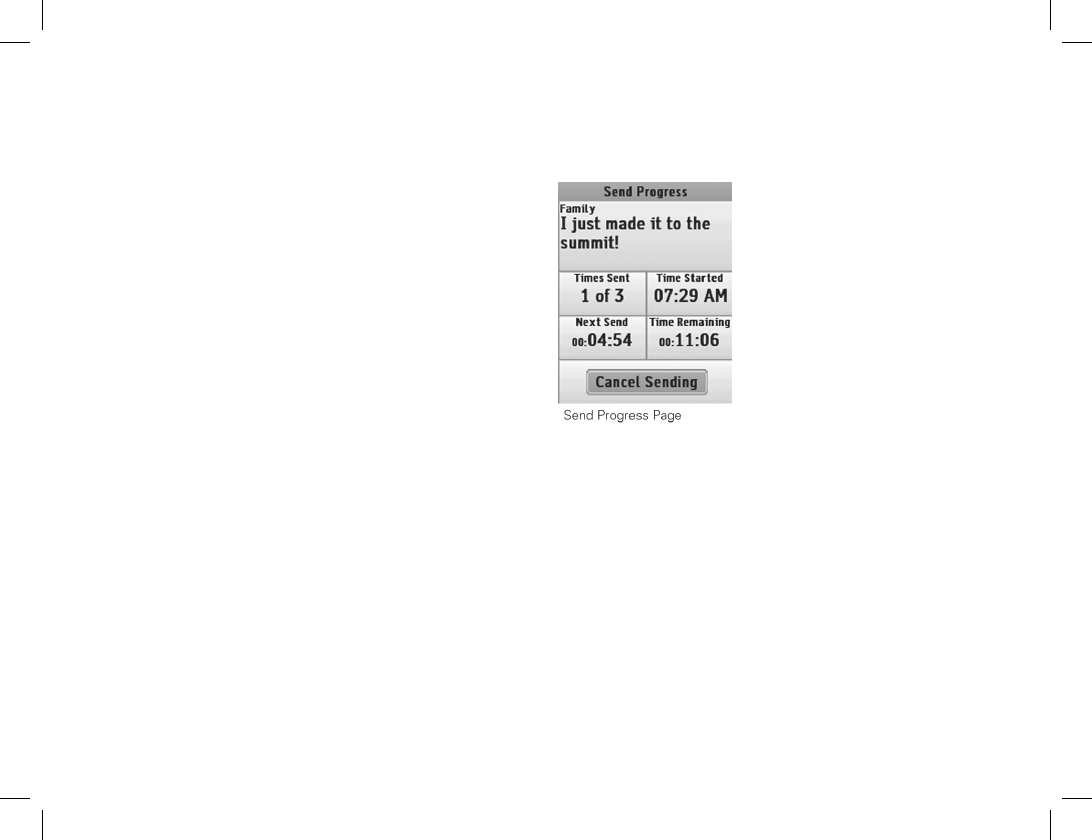
41
Sharing Reference Point Information
Use the SPOT Communicator to send information about
a reference point (dened as any point on the map other
than where you are), geocache, Find search result, or map
point from the PN-60w to your contacts. While viewing
details for a point or search result, go to MENU > Send
Point with SPOT. The SPOT Communicator page will
open for you to complete your message.
Logging Geocaches and Uploading
Field Notes
With the SPOT Communicator and PN-60w, you can
log a geocache nd and write a eld note in the eld and
immediately send the information to Geocaching.com.
Link your premium Geocaching.com account to your
account at ndmespot.com before you go into the eld.
This will allow you to log a geocache or upload eld notes
in near real-time from virtually anywhere with the SPOT
Communicator.
For more information, see To log a geocache on page 58.
Send Progress Page
Once you have sent a message, the Send Progress page
displays information about the message currently in
progress. When the SPOT Communicator status indicates
that a message mode is in progress, you can select that
message type to view the Send Progress page.
The Send Progress page displays the following
information about the message:
Message–The message recipient and the content
of the message.
Times Sent–The number of times the message has
been sent. While a single message transmission has
a good probability of being received, waiting for the
full three message transmission to complete gives
the highest probability of a successful delivery.
Time Started–The time the message was initiated.
Time to Next Send–Displays the amount of time
remaining until the SPOT Communicator sends
the next message.
The SPOT Communicator Page

42 The SPOT Communicator Page
Time Remaining–Displays the amount of time
remaining until the message is complete.
To cancel sending
You can cancel a message that is in progress. Select
Cancel Sending and press ENTER. If the Message
Progress page is still active after all of the messages
for a message type have been sent, the Cancel button
changes to Done. Returning to the SPOT Communicator
Page after all of the messages have been sent shows
the Message Composition page.
Casual messages–Canceling Check-in/OK,
Reference Point, Geocache, and Track Progress
messages cancels the message and begins a three
minute timer before the next message can be sent.
Urgent and Critical messages–Canceling Help/
Assist and SOS messages cancels the message and
sends a Cancel Help, Cancel SOS, or Cancel Help
and SOS message.
For Help/Assist and SOS messages, the Send Progress
page shows that the SPOT Communicator is sending
a cancel message. If the rst message had not yet been
sent, a cancel message is not sent.
Message History
You can view a list of messages that have been sent from
the PN-60w with the SPOT Communicator. See all the
messages you've sent, when you sent them, and who
you sent them to.
To view message history
1. From the SPOT Communicator Page, go to MENU >
View SPOT Message History.
The Message History Page displays a list of messages;
the message type is indicated by an icon.
2. From the list, select the message you want to view
and then select one of the following:
»View Message Details–Displays the Send
Progress page for each message.
»View on Map–Displays the location from which
the message was sent and the waypoint icon for
the message type.
Note You can also view your message history from
the last 30 days in your account at ndmespot.com.
From the Message History page, go to MENU > Export
Message History. You can save the message history
on the internal drive or to an SD card in the device.

43
To clear message history
From the Message History page, go to MENU > Clear
Message History. All the messages in the history are
cleared and the message waypoint icons are removed
from the map.
Visit the DeLorme Wiki at wiki.delorme.com for more
information. The latest version of the User Manual is always
available for download.
The SPOT Communicator Page
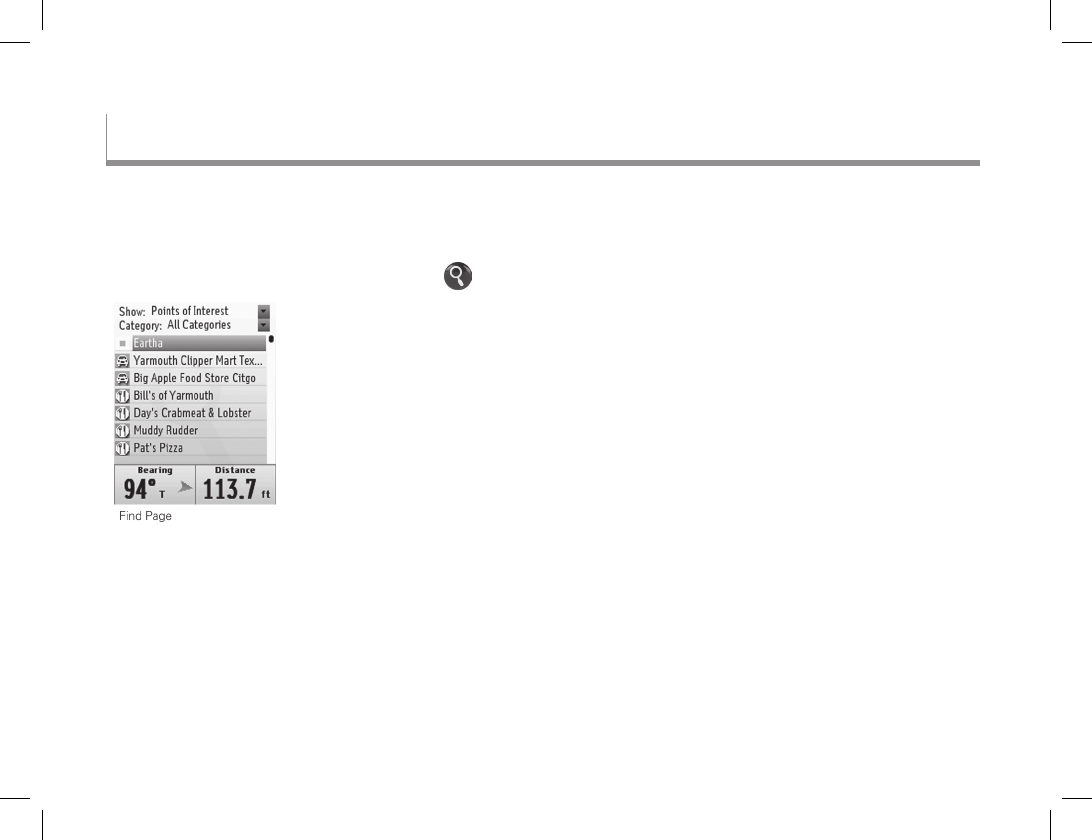
44
Use the Find Page to search for addresses, roads,
cities, points of interest (POIs), waypoints, geocaches,
coordinates, and more.
To view the Find Page, press the Find button .
Search Methods
There are two ways to search—near map center or
by name; the most recent method you use is saved
between searches.
Find Near Map Center–The device searches from
the current GPS location. If GPS is turned off or if you
are panning the map or viewing another location, the
search is from the current map center. The search
continues until the maximum number of search
results (100) is found.
Find by Name–Use this option to search for a
specic location by its name. Results are listed
alphabetically.
Narrow a Name search with the Name Contains or
Name Begins with options—press MENU to access
them. Then, in the Name eld, type one or more
characters that the name begins with or contains; the
more letters you enter, the more relevant your search
results are.
» For some search types, you can also narrow
your search with additional parameters, such as
categories or symbols.
» When the City, State, or Country elds are
available, the more information you enter, the
more rened your search results are. If you do
not enter anything or if those elds are unavailable,
the search starts from the map center.
» To clear all elds into which you have entered
information, go to MENU > Clear All Fields.
The Find Page
The Find Page

45
The Find Page
To view the current search method
Go to Find > MENU. The available options are preceded
by "Switch to..." and the device is set to the option that
is not showing. To change the search method, select the
method you want to use.
Searching for a Location
To search for a place, press Find at any time. The device
will begin searching using the most recent search criteria.
You can change the search method.
You can use additional search parameters, when
available, to narrow your search.
"Searching >>>" displays as the device searches for
locations.
At any time, press the arrow keypad to stop the
search process.
If you stop the search, select Continue Search to
keep searching.
Show
The Show eld is the primary search category. You can
select the following Show options; below each option
is a list of information you can change to improve your
search results.
All
State/Country/City/Name (Find by Name only)
Recent Finds–Shows the ten most recent search
results.
Draw Layers (appears only if you have draw layers
on the device)
Name (Find by Name only)
GIS Layers (appears only if you have GIS layers
on the device)
Name (Find by Name only)
Waypoints (from the current waypoint le)
Symbol
Name (Find by Name only)
Geocaches (from the current geocache le)
Symbol
Name (Find by Name only)
Points of Interest
Category
State/Country/City/Name (Find by Name only)
Natural Features
Category
State/Country/City/Name (Find by Name only)
DeLorme Atlas & Gazetteer Points
Category
State/Country/City/Name (Find by Name only)
Addresses
State/Country/City/Building Number/Street Name
(Find by Name only)
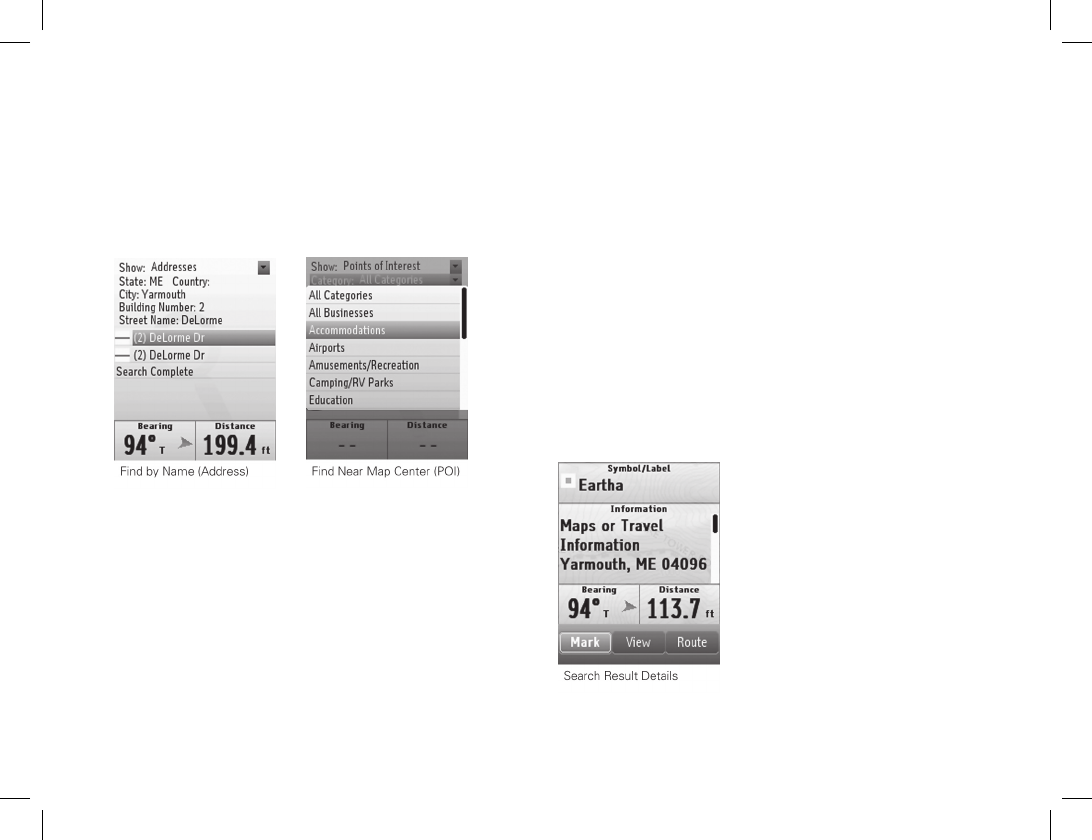
46
Coordinates
Coordinates can be edited.
Streets/Trails
State/Country/City/Name (Find by Name only)
Cities
State/Country/Name (Find by Name only)
To edit/change search elds
When a eld is highlighted, you can edit or change it.
To edit a eld, press ENTER and use the available option
(drop-down list, arrow keypad, or keyboard) to make
changes. When you are nished editing, press ENTER.
Search Results
Search results are displayed in a list. When you highlight
an item in the list, the Bearing and Distance info elds
display measurements as follows:
From the GPS position when the device has a GPS x.
From the cursor location if you are manually panning
or viewing another location.
From the map center if GPS is turned off.
To view the results list
To view the results, use the arrow keypad to scroll
through the list, or press the IN/OUT button to go
forward or backwards a page at time. The maximum
number of results for each search is 100.
To view search result details
To view the details for an item on the list, select it.
The search result details page displays.
The Find Page

47
The Find Page
To mark a waypoint for a search result
On the search result details page, select Mark. The result
is saved as a waypoint and the waypoint details page
displays; you can edit the information. For more
information see To edit waypoint details on page 50.
To view/center a search result on the map
On the search result, waypoint, or geocache details
page, select View. The Map Page displays and is
centered on the search result. Press QUIT to return
to the details page.
To create a route to a search result
You can navigate directly to the search result from your
current location. For more information about creating and
modifying routes, see The Routes Page starting on page 61.
1. On the details page for the search result,
select Route.
2. On the route details page, select Navigate.
Note When you are creating a route from
a geocache details page, go straight to step 3.
3. Select Hike or Drive.
The route calculates and the Map Page opens
in navigation mode.
Visit the DeLorme Wiki at wiki.delorme.com for more
information. The latest version of the User Manual is always
available for download.
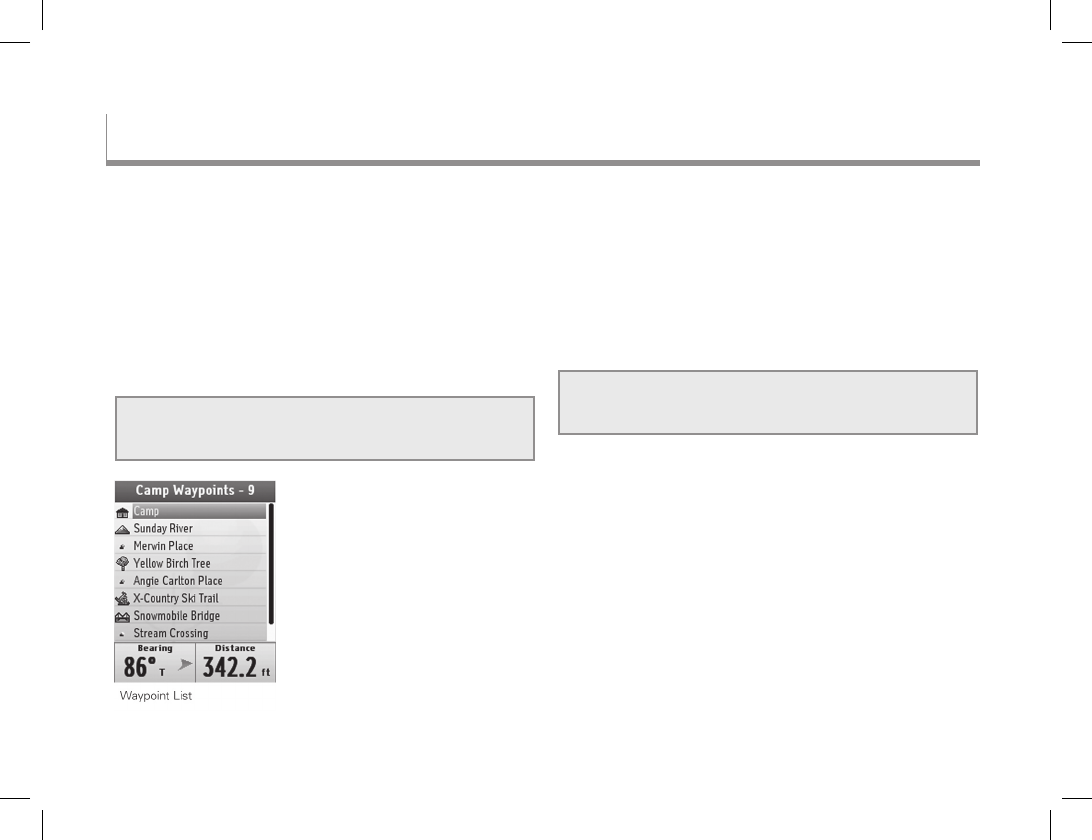
48
A waypoint is a location that you mark and store using the
PN-60. You can also transfer waypoint les to the PN-60.
Waypoints are identied by coordinates, and you can
assign a symbol, name, and other information to them.
The Waypoints Page lets you view a list of the active
waypoints on your PN-60. Waypoints are active when you:
Open a waypoint le
Mark a new waypoint
XMap users See the supplemental online help on the
DeLorme Wiki (pnseries.wiki.delorme.com/xmap) for
information about using XMap with the Waypoints Page.
For information about geocache waypoints, see
The Geocaches Page section starting on page 53.
Managing Waypoint Files
Waypoints are managed using GPX les; each le can
contain up to 1,500 waypoints. For more information
about GPX les, see File Management starting on page 85.
Tip Use Find to quickly locate a waypoint in the open waypoint
le. For more information, see The Find Page section starting
on page 44.
Waypoint List
The Waypoints Page displays a list of waypoints from the
GPX le open on your device. The le name and the
number of waypoints in the le appear at the top of the
page. When you highlight a waypoint in the list, the
Bearing and Distance info elds display measurements
as follows:
From the GPS position when the device has a GPS x.
From the cursor location if you are manually panning
the map.
From the map center if the GPS receiver is turned off.
The Waypoints Page
The Waypoints Page

49
The Waypoints Page
Sorting the List
There are two ways to sort your list of waypoints—
by distance from your GPS location or alphabetically
by name. From the Waypoints Page, press MENU; the
device is set to the option that is not showing. To switch
to the highlighted option, press ENTER. If the le has
a large number of waypoints, press ENTER to interrupt
the sorting process and see a partial list.
Symbols
The waypoint symbols available on the PN-60 match
the PN-Series symbol set in your DeLorme mapping
application. The symbol set includes geocaching symbols
(these are at the end of the symbol list). To ensure
a waypoint displays on the Waypoints Page, use a
waypoint symbol. If you use a geocaching symbol, the
waypoint will display only on the Geocaches Page. To see
the geocaching symbols, go to page 54. For a complete list
of symbols, see the DeLorme Wiki (wiki.delorme.com).
File Menu
Use the File menu to manage waypoint GPX les stored
in the PN-60’s internal memory or on an SD card in the
device, as well as waypoints you create on the device.
For more information about les, see File Management
on page 85.
To open the File menu, from the Waypoints Page, go to
MENU > File. The following options are available:
New—Create a new GPX le and name it. When you
turn off the device, the le will be automatically saved.
Open—View a list of GPX les in internal memory and
on the SD card. Select the le you want to open and
press ENTER to view the waypoints on the device.
Save As—Save the open le as a new le, name it,
and select the location for the le. If you have made
any changes to the open le, the changes are saved
in the new le—the original le does not retain the
changes.
Move to Internal/Move to SD Card—Move the
open le from the current stored location to the
alternate location. For example, you can open a le
from an SD card and move it to the device’s internal
memory.
Close – Close the open GPX le.
Marking a Waypoint
Use the Mark button on the PN-60 to mark a waypoint at
your current GPS location or at the map cursor if you are
viewing another location on the map. When the waypoint
is marked at the map cursor location, the elevation is not
available.

50
When you press Mark, the waypoint is saved and a
waypoint details page opens where you can edit the
waypoint details. For more information, see To edit
waypoint details.
You can also mark waypoints using the on-screen
Mark option on Find search result details and route
point details pages.
When you mark a waypoint, the default waypoint symbol
is a red map pin and the label is "Wpt 001." When you
change the symbol or label, each new waypoint uses that
format until you change either the symbol or the name.
When you add multiple waypoints with the same name,
a sequential number is added to the name. For example,
if you name a waypoint “Campsite,” the second waypoint
is named “Campsite 002” and so on.
When you mark a waypoint from a details page, such as
a Find search result or a map object, the device uses the
default information available for the symbol and name.
If no information is available, the red map pin is the
default symbol.
To mark a waypoint on the map
From the Map Page, press Mark to save the waypoint
and open a new waypoint details page.
On the waypoint details page, you can do the following:
Edit the waypoint details.
Delete the waypoint.
View the waypoint on the map. To return to the
waypoint details page, press QUIT.
Create a route to the waypoint.
For more information, see the Managing Waypoints section.
To mark a waypoint from a search result
or route point
On a Find search result details page or a route point
details page, select Mark on the screen. The result is
saved as a waypoint and the waypoint details page
displays; you can edit the information.
Managing Waypoints
To view waypoint details
Use the waypoint details page to view detailed
information about a waypoint.
From the Waypoints Page, select a waypoint and
press ENTER. The waypoint details page opens.
To edit waypoint details
On a waypoint details page, you can customize the
waypoint symbol, label (name), coordinates, elevation,
time/date, and comments.
The Waypoints Page

51
The Waypoints Page
To edit a eld, use the arrow keypad to highlight it and
press ENTER. Use the available option (drop-down list,
arrow keypad, or keyboard) to make changes. When you
are nished editing, press ENTER.
To view comment details
From the waypoint details page, go to MENU >
View Comment Details.
Note When navigating, the View Comment Details
option is also available from the Map, Compass, Trip Info,
and Directions pages. The comment for the most recently
viewed point is displayed.
To view/center a waypoint on the map
From the waypoint details page, select View; press QUIT
to return to the waypoint details page.
To move the waypoint to the current
GPS location
From the waypoint details page, go to MENU > Move to
GPS Location. When you see the conrmation message,
select Yes.
To create a route to a waypoint
You can navigate to a waypoint from your current location.
All driving routes and hiking routes with multiple points
are automatically saved. For more information about
creating and modifying routes, see The Routes Page
starting on page 61.
1. On the waypoint details page, select Route.
2. On the route details page, select Navigate.
3. Select Hike or Drive.
The Map Page opens in navigation mode.
To delete a waypoint
From the waypoint details page, go to MENU > Delete
Waypoint. When you see the conrmation message,
select Yes.
To delete waypoints by symbol
1. From the Waypoints Page, go to MENU >
Delete by Symbol.
2. On the Waypoint Symbols page, select the check box

52
for each symbol you want to delete. Only symbols
used in the current le are listed.
3. Select Delete. When you see the conrmation
message, select Yes.
The waypoints with that symbol in the current le
are deleted from the le.
Averaging a Waypoint
When you average a waypoint, the PN-60 records a
series of GPS readings for the waypoint’s location and
averages them to increase the positional accuracy of the
waypoint. As you average the waypoint, the GPS status,
coordinates, elevation, number of readings at the location,
and estimated accuracy display. Multiple readings improve
the positional accuracy of the waypoint. The estimated
accuracy number decreases as the accuracy improves.
To average a waypoint
From the waypoint details page, go to MENU > Average
Waypoint. When the device has recorded the number
of readings you want, press ENTER.
Tip Average your location during multiple visits, at different
times of the day to get the best results. Always place the
device in the same location to average the waypoint.
Projecting a Waypoint
You can project a waypoint at a new location by providing
the bearing and distance from an existing waypoint.
To project a waypoint
1. From the waypoint details page, go to MENU >
Project Waypoint.
2. Enter the information for projected waypoint in the
Bearing and Distance elds.
3. Select Move to move the existing waypoint or
Create New to mark a new waypoint at the projected
location. Then, press ENTER.
Visit the DeLorme Wiki at wiki.delorme.com for more
information. The latest version of the User Manual is always
available for download.
The Waypoints Page
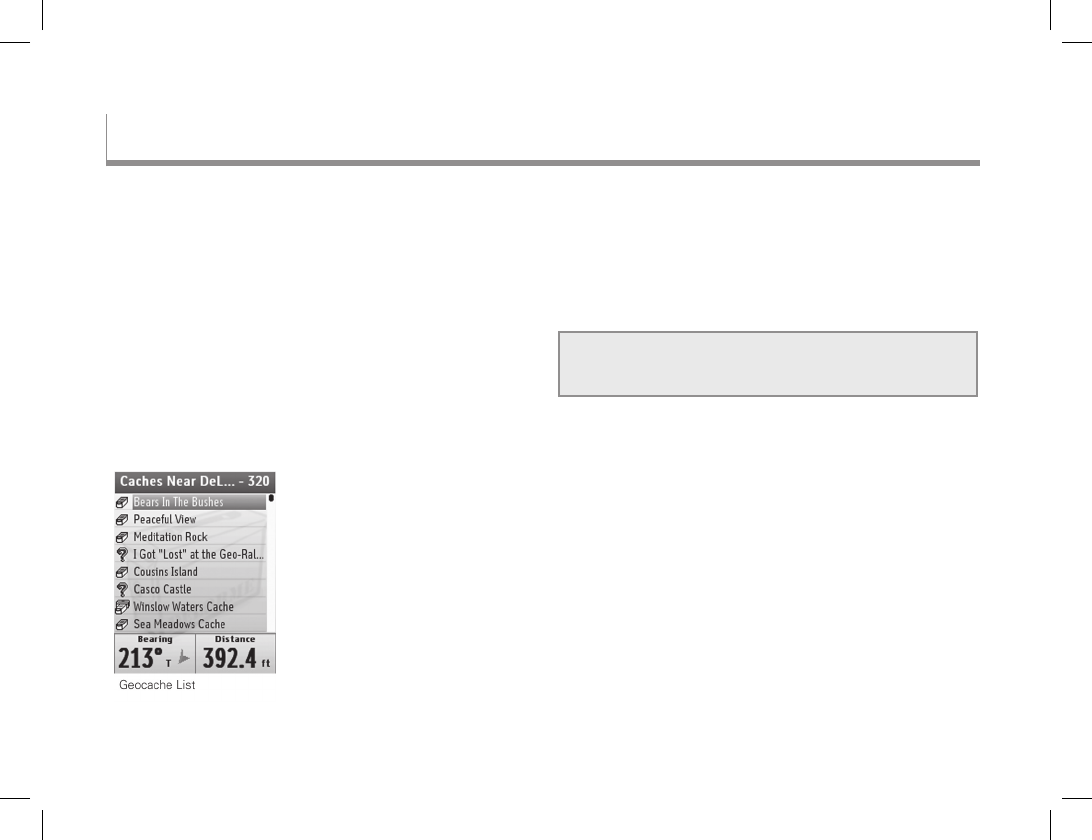
53
Geocaching is a treasure hunting game where you use
a GPS device to search for geocaches—containers that
include a log for you to record your visit. Some geocaches
have trinkets you can take—just follow the “take one,
leave one” rule. To nd out more about geocaching,
visit Geocaching.com.
On the PN-60, a geocache is a special type of waypoint
used for geocaching. The Geocaches Page lets you view
a list of the active geocaches on your PN-60. Geocaches
are active on your PN-60 when you open a waypoint le
that contains geocaches.
Managing Geocache Files
Geocaches are managed using waypoint GPX les;
each le can contain up to 1,500 geocaches and child
waypoints. For more information about GPX les, see
File Management on page 85.
Tip Use Find to quickly locate a geocache in the open waypoint
le. For more information, see The Find Page section starting
on page 44.
Geocache List
The Geocaches Page displays a list of active waypoints
from the GPX le open on your device. The le name
and the number of geocaches and any child waypoints in
the le appear at the top of the page. When you highlight
a waypoint in the list, the Bearing and Distance info elds
display measurements as follows:
From the GPS position when the device has a GPS x.
From the cursor location if you are manually panning
the map.
From the map center if the GPS receiver is turned off.
The Geocaches Page
The Geocaches Page
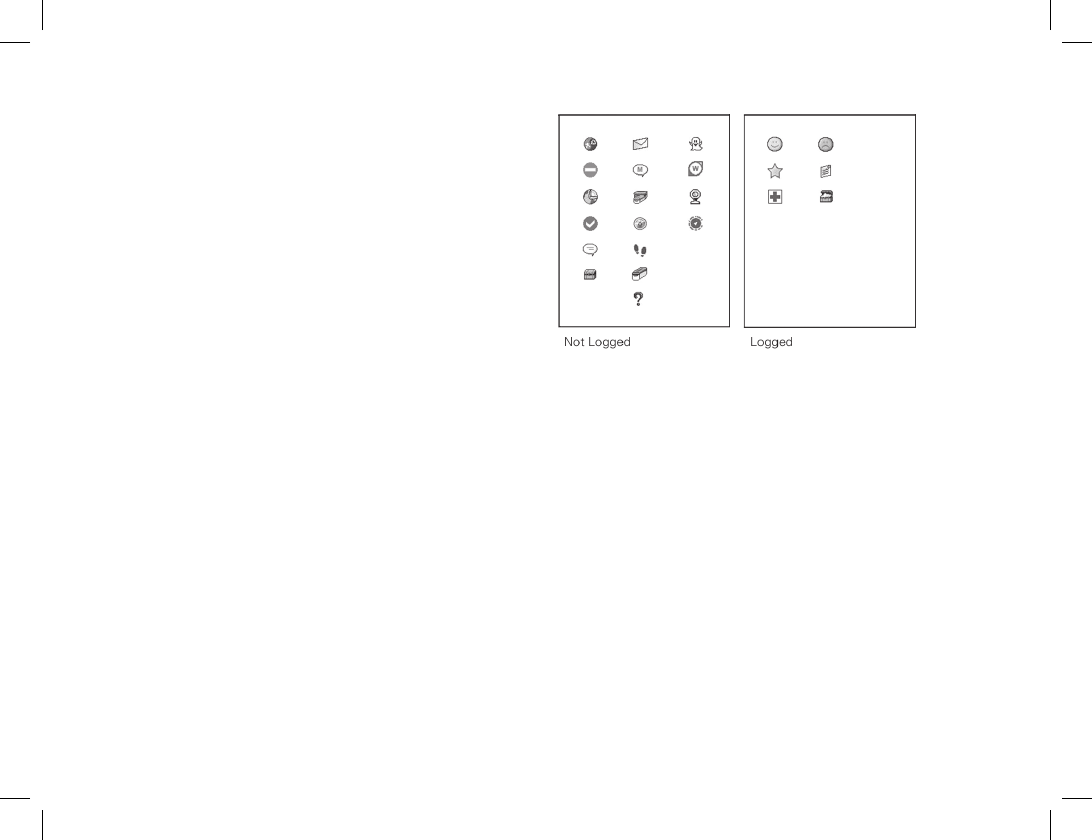
54 The Geocaches Page
Sorting the List
The Geocaches Page is automatically sorted into two
separate lists—logged and not logged—based on the
geocaching symbol type. You can sort the list you are
viewing by the distance from your GPS or map location
or sort alphabetically by name.
The device is set by default to sort by name. To change
the sorting method, press MENU, highlight the sorting
method to use and press ENTER. If the le has a large
number of geocaches, press ENTER to interrupt the
Sorting Geocaches process and see a partial list.
Symbols
Geocache symbols come from Geocaching.com and
are also available in the PN-Series symbol set in your
DeLorme mapping application. For a printable list of
symbols on the device, see the DeLorme Wiki (wiki.
delorme.com).
When you change a geocache symbol, be aware that it
may affect how the geocache is displayed on the device.
For example, if you choose a waypoint symbol, the
geocache will move to the Waypoints Page and if you
change a symbol from a not logged to a logged symbol
type, it will move from the Show Not Logged to the Show
Logged list.
File Menu
Use the File menu to manage geocache (waypoint) GPX
les stored in the PN-60’s internal memory or on an SD
card in the device, as well as geocaches you create on the
device. To open the File menu, from the Geocaches Page,
go to MENU > File. The following options are available:
New–Create a new GPX le and name it. When you
turn off the device, the le will be automatically saved.
Open–View a list of GPX les in internal memory and
on the SD card. Select the le you want to open and
press ENTER to view the waypoints on the device.
Save As–Save the open le as a new le, name it, and
select the location for the le. If you have made any
changes to the open le, the changes are saved in the
new le—the original le does not retain the changes.

55
Move to Internal/Move to SD Card–Move the open
le from the current stored location to the alternate
location. For example, you can open a le from an SD
card and move it to the device’s internal memory.
Close–Close the open GPX le.
How to Add Geocaches to the PN-60
Use one of the following methods to send geocaches
to your device.
DeLorme Topo North America™ 9.0–Use
Earthmate® GPS Sync to sync GPX les, including
Pocket Queries from Geocaching.com, and then send
them to your device. See the program's Help for more
information.
DeLorme Send to GPS Plugin–This free plugin is
available to members of geocaching.com. Once you
nd a geocache on the Geocaching.com website,
send it directly to your PN-60. See To use the
Send to GPS plugin.
DeLorme Cache Register™–Cache Register is a
desktop computer utility you can use to send pocket
queries (groups of geocaches) from Geocaching.com
to a PN-60. You must be a premium member of
Geocaching.com to create pocket queries. To purchase
Cache Register, visit our website (delorme.com).
See the program's Help for more information on how
to use Cache Register.
Note Cache Register is compatible with Apple®
computers.
To use the Send to GPS plugin
With the DeLorme Send to GPS plugin, you can send one
geocache at a time to a PN-60. You must be logged in
to Geocaching.com to use this feature. Please note that
geocache descriptions and hints are available only for
premium members of Geocaching.com.
1. Connect your PN-60 to your computer. The device
should be set to the default Connect to Computer
setting—Use GPS.
2. On Geocaching.com, use the Seek a Cache feature
to nd the geocaches in your area of interest.
3. From the results list, click the Send to GPS icon or
view the geocache’s details and click the Send to
GPS button.
4. The DeLorme Send to GPS plugin opens and
transfers the geocache to your device.
5. Repeat step 3 to send each geocache to your device.
Managing Geocaches
To view geocache details
Use the geocache details page to view information about
a geocache, when available.
The Geocaches Page
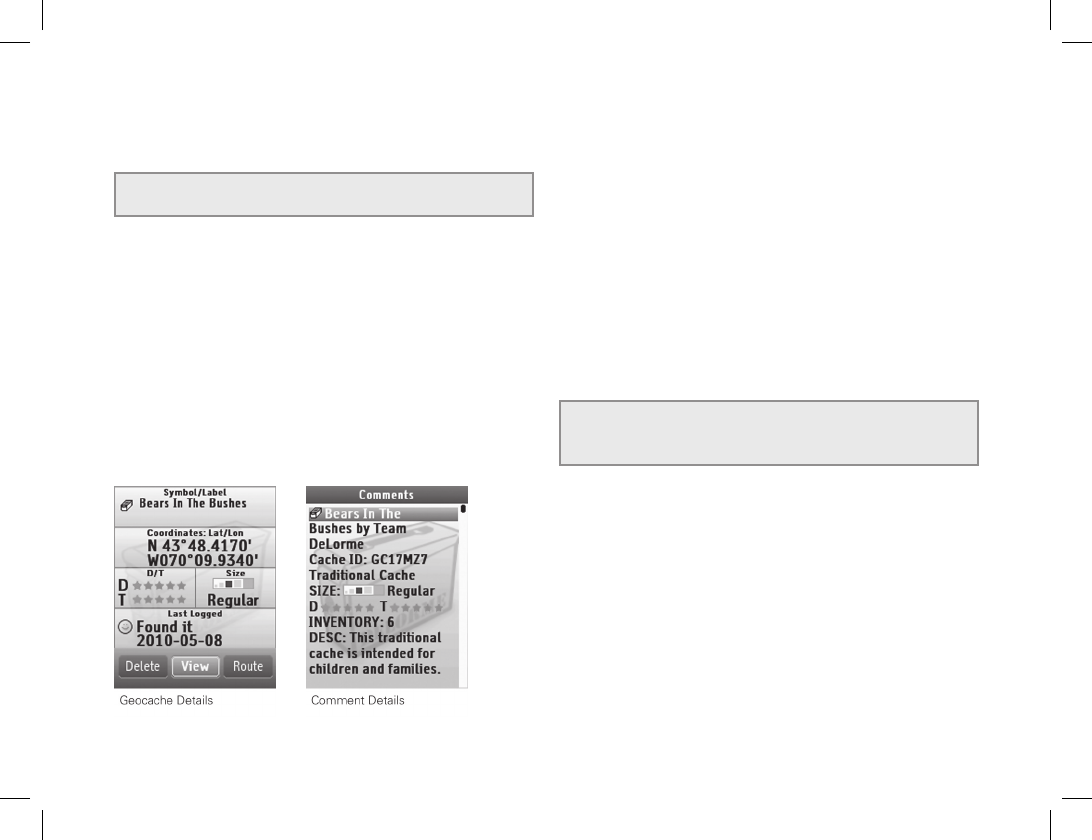
56 The Geocaches Page
From the Geocaches Page, select a geocache and press
ENTER. The geocache details page opens.
Tip The Last Logged eld on the geocache details page
displays the rst two lines of the most recent log entry.
To edit geocache details
You can edit the symbol, label, and coordinates. You
can edit comment details for geocaches you have
created on the device. Changes you make to the
geocache details on your device do not update
information on Geocaching.com.
To edit a eld, select it and press ENTER and use
the available option (drop-down list, arrow keypad, or
keyboard) to make changes. When you are nished
editing, press ENTER.
To view comment details
Comment details give you detailed information about the
geocache, such as the cache ID, the size, the difculty
and terrain, as well as the full description, the hint, and
the full log. Note .loc les do not include comments.
From the geocache details page, go to MENU >
View Comment Details.
Note When navigating to a waypoint or geocache, the
View Comment Details option is also available from the
Map, Compass, Trip Info, and Directions pages. The
comment for the most recently viewed point is displayed.
Tip Press the Out button to move through the comment one
page at a time. Press the Up arrow on the arrow keypad to
move to the end of the comment.
To view the geocache hint
To quickly view the geocache hint, from the geocache
details page go to MENU > View Hint.
To view/center a geocache on the map
From the geocache details page, select View; press
QUIT to return to the geocache details page.
To move the geocache to the GPS location
From the geocache details page, go to MENU > Move to
GPS Location. When you see the conrmation

57
message, select Yes. The geocache’s location information
will update to the current GPS location.
To delete a geocache
From the geocache details page, go to MENU > Delete
Geocache. When you see the conrmation message,
select Yes.
To delete geocaches by symbol
From the Geocaches Page, go to MENU >
Delete by Symbol.
1. On the Geocaches Symbol page, select the check box
for each symbol you want to delete. Only symbols
used in the current le are listed.
2. Select Delete. When you see the conrmation
message, select Yes.
The geocaches with that symbol in the current le
are deleted from the le.
Averaging a Geocache
When you average a geocache, the PN-60 records a
series of GPS readings for the geocache’s location and
averages them to increase the positional accuracy of the
geocache. As you average the geocache, the GPS status,
coordinates, elevation, number of readings at the location,
and estimated accuracy display. Multiple readings improve
the positional accuracy of the geocache. The estimated
accuracy number decreases as the accuracy improves.
To average a geocache
From the geocache details page, go to MENU > Average
Geocache. When the device has recorded the number
of readings you want, press ENTER.
Tip Average your location during multiple visits, at different
times of the day to get the best results. Always place the
device in the same location to average the geocache.
Projecting a Geocache
You can project a geocache at a new location by providing
the bearing and distance from an existing geocache.
To project a geocache
1. From the geocache details page, go to MENU >
Project Geocache.
2. Enter the information for projected geocache in the
Bearing and Distance elds.
3. Select Move to move the existing geocache or
Create New to mark a new geocache at the projected
location. Then, press ENTER.
The Geocaches Page
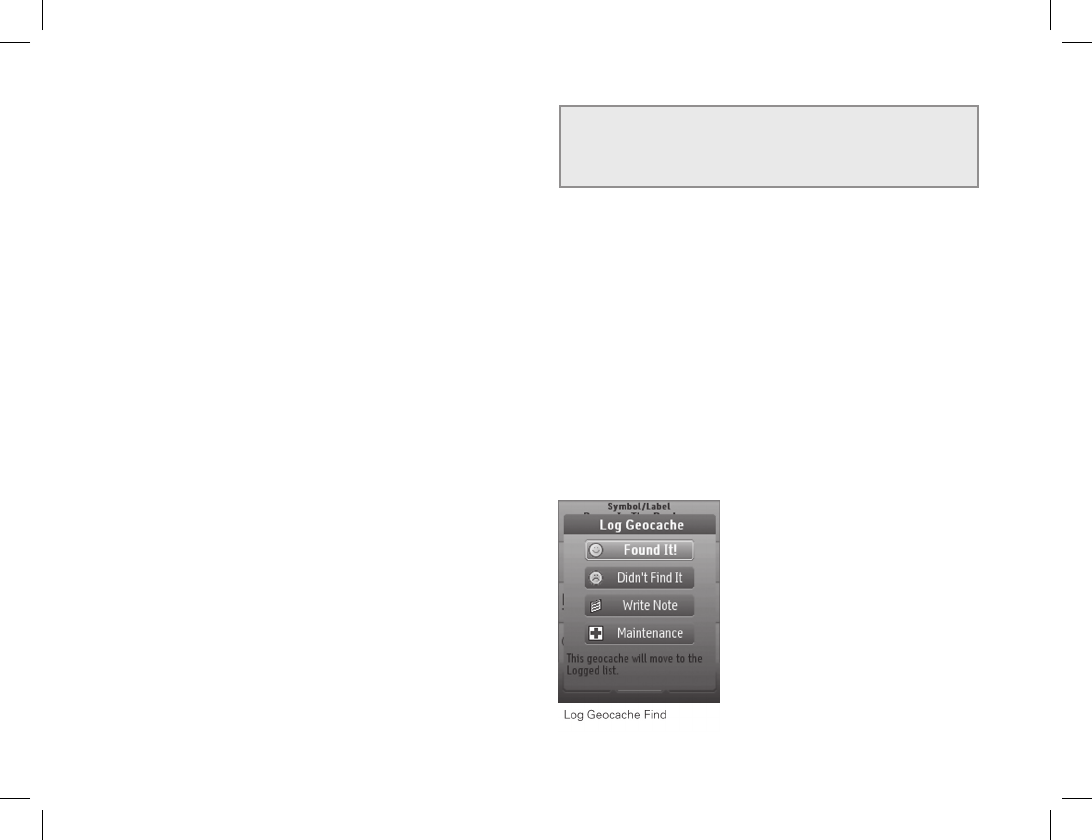
58
Tip With a SPOT Communicator paired with your PN-60w,
you can wirelessly log geocaches and upload eld notes to
Geocaching.com. Select the option to log the nd with your
SPOT device and follow the on-screen instructions.
To log a geocache
When navigating, you can log a geocache from the Map,
Compass, Trip Info, or Directions pages. You can also log
a geocache at any time from its details page.
1. Go to MENU > Log Your Geocache Find.
2. Select the log option: Found It!, Didn't Find It,
Write Note, and Maintenance. Any of these actions
changes the geocache symbol to the one on the
button you choose and moves the geocache to the
Show Logged list.
3. Write a eld note or leave the default information
and select Done.
The Geocaches Page
Geocaching
Out in the eld, pick a geocache to start with and then
use the PN-60 to navigate to, log, and write eld notes
for one geocache or a series of geocaches.
To navigate to a geocache
Navigate from your current location to the rst geocache
on your list. Once you log your nd, the PN-60 nds the
next geocache for you. Routes to geocaches are not
saved on the device.
1. On the geocache details page for the rst geocache
on your Not Logged list, select Route.
2. Select Hike or Drive.
The route calculates and the Map Page displays in
navigation mode.
3. Navigate to the geocache.
4. When you are ready to log the geocache, go to
MENU > Log Your Geocache Find.
5. Write a eld note or leave the default information and
select Done.
6. On the Next Geocache screen, select an option:
»Find Next Closest–View the details page for the
next geocache and go back to step 1.
»View List–View the Not Logged list and
pick your own geocache.
»Stop Geocaching–Stop navigating and geocaching.
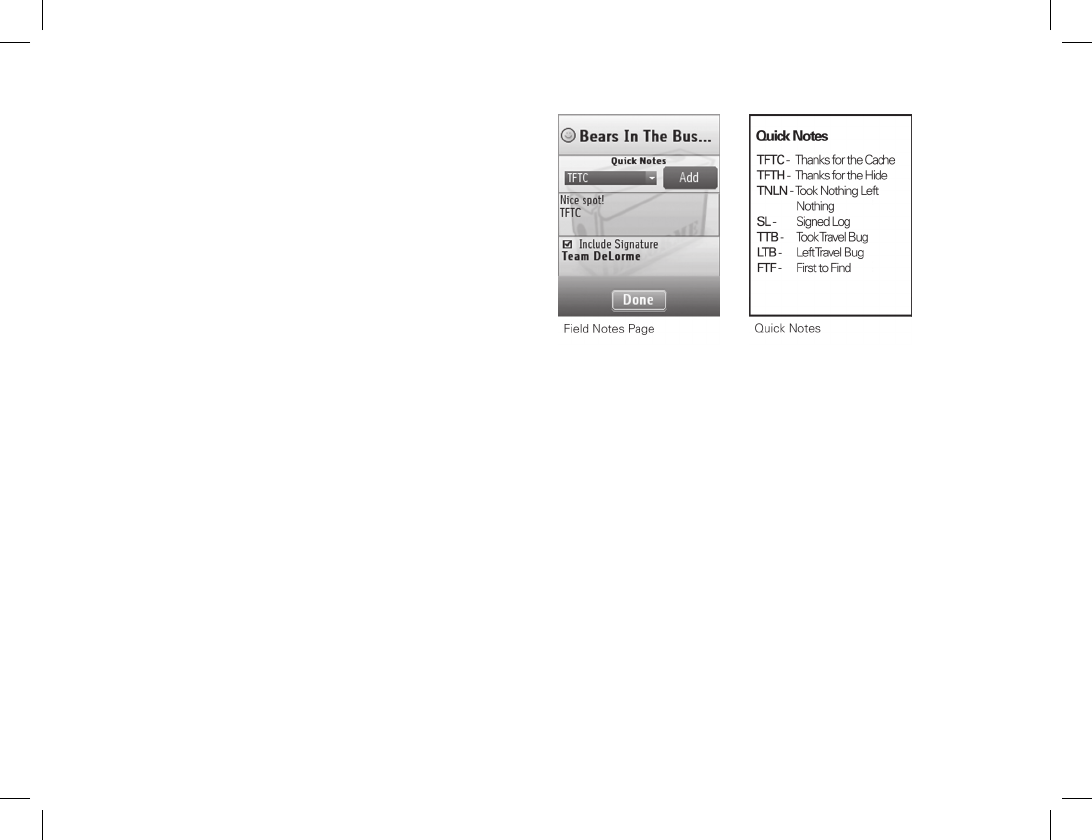
59
To write a eld note
When you log a geocache, you can write a eld note
that you can later upload to Geocaching.com.
1. Log a geocache.
2. On the Field Notes page, you can use one or all of
the elds to create a eld note:
»Quick Notes–This drop-down list includes a list of
acronyms used by geocachers for logging caches.
Select the note from the drop-down list and then
select Add. You can add multiple quick notes.
»Your Notes–To add your own notes, highlight the
comment area and press ENTER.
»Signature–At the bottom of the screen, you can
enter a 2-line signature. Highlight Enter signature
text and press ENTER to open the keyboard.
Ensure the Include Signature check box is
selected to automatically add your signature to all
eld notes that you create.
3. Select Done.
To view eld notes
From the Geocaches Page, go to MENU > View Field
Notes to see a list of the caches for which you added
a eld note.
To upload eld notes
You can upload eld notes from your device to
Geocaching.com with the Earthmate GPS Sync dialog
in Topo North America, a SPOT Communicator paired
with your PN-60w, Cache Register, or the DeLorme Field
Notes page on Geocaching.com. See the Help for each
application for complete instructions. For the SPOT
Communicator, select the option to log your nd with
SPOT and follow the instructions on the PN-60w.
The Geocaches Page

60
Apple® computer users When your device is connected to
your computer, manually eject the EM_USERMAPS drive after
use; if you do not, the drive is forcefully ejected and could harm
both the device and disrupt other USB drives connected
to the computer.
Visit the DeLorme Wiki at wiki.delorme.com for more
information. The latest version of the User Manual is always
available for download.
The Geocaches Page
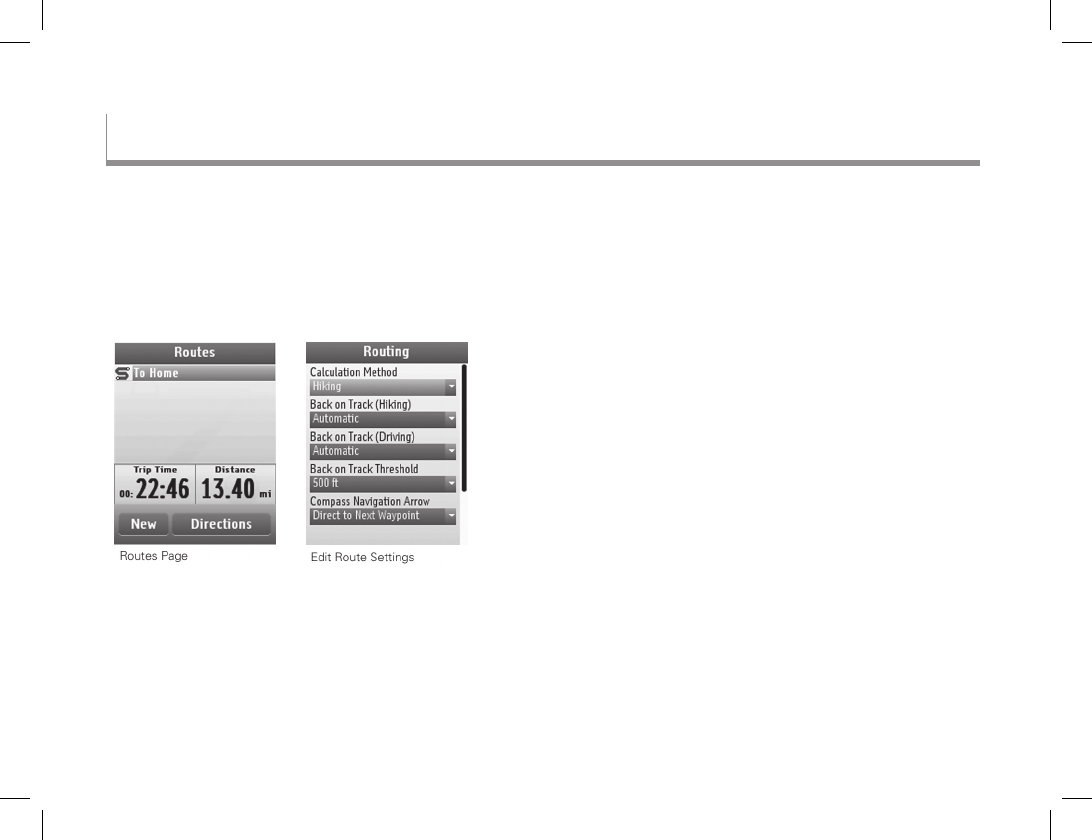
61
The Routes Page displays a list of routes you have created
on the device and routes you have sent to the device with
a DeLorme mapping application. Using DeLorme Topo
North America™ or XMap® to plan routes on the desktop
for transfer to the PN-60 ensures you take exactly the road
route you want and is the best way to create long routes.
In the routes list, hiking (direct) routes have a yellow “Z”
icon and driving routes have a blue curved line icon. The
active route name appears in bold text. You can save
up to 100 routes on the device.
Route Settings
Use route settings to determine the route calculation
method, back on track options, and hiking route options.
From the Routes Page, press MENU and select
Edit Route Settings.
To edit route settings
Select the route option you want to change and then
select the new setting.
Calculation Method–Determines the option (Hike
or Drive) to use when you create a route and is the
default method when viewing a route that has not
been calculated. From the drop-down list, select
Hiking or Driving.
Back on Track (Hiking)/Back on Track (Driving)–
Sets the option for informing you that you are off course
and showing the way back to the route. When the
route recalculates, the route highlight is cleared from
the start to the current GPS location. The original route
is not modied; you can select it again to restore it.
»Hiking–Select Automatic to continuously
recalculate from the current GPS location to the
The Routes Page
The Routes Page

62 The Routes Page
next stop in the route. Select Prompt to alert
you when you are off track; you can then choose
to recalculate or ignore. Select Off if you do not
want to use Back on Track. Also, select Off for trail
routes sent to your device from DeLorme Topo
North America or XMap—if the route recalculates,
it will be converted to a direct route to the nish.
»Driving–Select Automatic to recalculate based
on how far off the route you are. Select Prompt
to alert you when you are off track; you can then
choose to recalculate or ignore. Select Off if you
do not want to use Back on Track.
Back on Track Threshold–For driving routes, sets
the distance threshold for initiating a back on track
calculation. Select a distance from the drop-down
list. A large value prevents excessive prompts, while
a small value recalculates as soon as you are
off the route.
Compass Navigation Arrow–In the event you go
off your route when navigating a hiking route, you can
choose to have the bearing arrow point to the next
waypoint in your route (best when trying to get to the
next waypoint by the shortest distance) or point back
to the route (best if you want to follow a specic path).
Select Direct to Next Waypoint or Back on Course
from the drop-down list.
Hiking Route Calc Speed–The walking speed that
the device uses to calculate a walking route. Press
ENTER and use the arrow keypad to make changes.
When you are nished editing, press ENTER.
Restore Default Settings–To restore the default
settings for all options, select Restore Default
Settings.
Create a Route
There are several ways to create a route on the PN-60:
When viewing a geocache, waypoint, or a Find search
result, you can create a route to it using the Route
option on its details page. See the appropriate section
of the manual for more information.
From the Routes Page, you can create a route to one
point or multiple points.
To create a route from the current position
Current Position is the default start point for a route. It’s
the current GPS location or, if GPS is turned off, the map
cursor position.
1. On the Routes Page, select New.
2. To use the default route name—the last point you add
to your route—go to step 3.
OR
To add a name for your route, highlight the New

63
Route eld, press ENTER, and use the keyboard to
make changes.
3. Ensure Add Point is highlighted and press ENTER.
4. Select the method for adding the point.
»Use Find–Opens the Find Page. Search for the
point you want to add; from the search result details
page, select Add.
»Use Map–Opens the Map Page. Pan the map to
the location you want to add and press ENTER.
You can add multiple points while panning. If there
are multiple objects at the cursor location, a list
displays—select the object from the list. When you
are nished adding points, press QUIT.
5. Repeat step 4 for each point in the route.
6. Select Navigate or View.
Note To save the route without navigating or viewing
it, press QUIT. The route is saved using the type
selected in the Calculation Method drop-down list in
the route settings.
7. If you selected Navigate, select the route method;
Hike or Drive. The route calculates and displays on
the map, and the device is in navigation mode.
OR
If you selected View, to hide the route, go to MENU >
Hide Route, press QUIT to return to the route details
page, and then select Hide. To begin navigating, press
QUIT to return to the route details page and select
Navigate.
Tip When you create a direct route from your current GPS
location to a single point and navigate to it, the route is
automatically deleted once you stop navigating.
To move, remove, or view details
for route points
As you add points to a route, you can view point details,
change the point’s order in the route, or remove the point
from the route.
Highlight the point and press ENTER; then select
an option.
Details–The details page for the point displays. The
options available depend on the type of point
you are viewing.
Move–Selects the point in the list; use the arrow
keypad to move the point up or down in the list order,
and then press ENTER.
Remove–Removes the point from the list. For
example, you can remove the Current Position eld
if you don't want to include it in your route.
Manage Routes
To view route details
On the Routes Page, select a route to open its details page.
The Routes Page
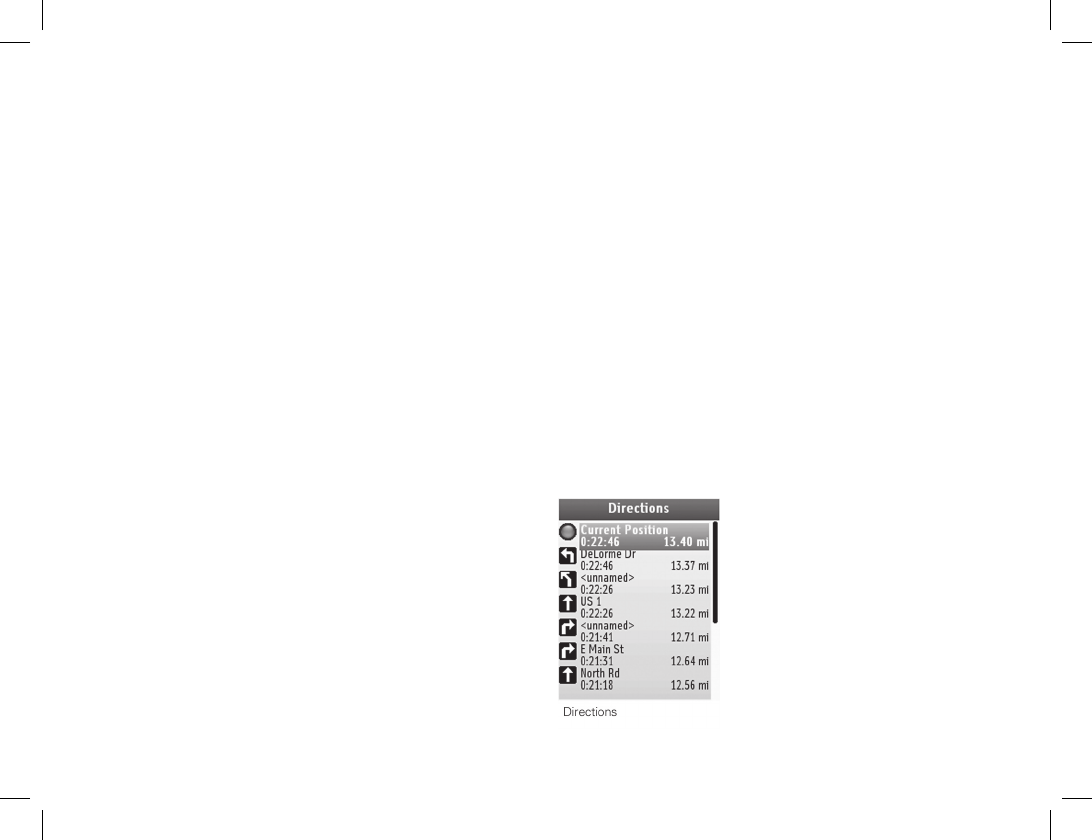
64 The Routes Page
If the route name is in bold text, it is displaying on the map.
To navigate with or view a saved route
on the map
1. From the route details page, select Navigate or View.
2. If the route has never been calculated, select Hike or
Drive. The route displays on the map. If you selected
Navigate, the device is in navigation mode. If you
selected View:
» To hide the route, go to MENU > Hide Route or
press QUIT to return to the route details page, and
then select Hide.
» To begin navigating, press QUIT to return to the
route details page and select Navigate.
To reverse a route
From the route details page, go to MENU > Reverse
Route. Then, on the route details page select
Navigate or View.
To simulate navigation
When you simulate navigation, track recording
is turned off.
From the route details page, go to MENU > Simulate
Navigation. When you see the Simulate Navigation
message, select OK. The Map Page opens and simulates
the route. You can access the following settings from any
default page except the Satellites Page.
To change the simulation speed, go to MENU >
Simulation Speed and then select a speed.
To stop simulation, go to MENU > Stop Simulation.
To delete a route
From the route details page, go to MENU > Delete
Route. When you see the conrmation message,
select Yes.
Directions Page
When you are navigating a route, the Directions page is
available in the PAGE button sequence. You can also view
the Directions page for the active route from the Routes
Page by selecting Directions.

65
To change the distance type
You can change the distance type that is displayed for
each step in the directions. The option you are using is not
displayed; to change to the available option, select it.
Show Distance to Finish–The distance from the
step to the end of the route.
Show Distance to Next Turn–The distance from
one step to the next step.
Other Menu Options
Additional options are available on the Routes Page menu
when you are navigating.
View Comment Details
When navigating, go to MENU > View Comment
Details to quickly view the comment for the waypoint
or geocache you are navigating to. The comment for
the most recently viewed point is displayed.
Log Your Geocache Find
When navigating to a geocache, use this option to quickly
log geocaches, write eld notes, and pick your next
cache. For more information about these features, see
The Geocaches Page section starting on page 53.
Route Options
When navigating, use Route Options to stop navigating,
get back on track, or switch the route type. For more
information about route options, see Route Settings
on page 61.
Visit the DeLorme Wiki at wiki.delorme.com for more
information. The latest version of the User Manual is always
available for download.
The Routes Page

66
A track is a recording of points along the path you travel—
use it to keep a log of your travels. From the Tracks Page,
you can turn track recording on and off, set the method
for recording track points, manage track les, and view
a track on the Prole Page. You can open a saved track
le while a new track is recording—both the active and
open track can display on the Map Page at the same time.
The Opened Track File area on the Tracks Page displays
information about a saved track le that you have opened
to view.
Viewing a Track on the Map
On the Map Page, you can view the active track and one
open track le at the same time.
An open track le is the color set in the track’s details (see
To view details for the open track on page 69). The appearance
of the active track is based on your GPS status.
3-D x–Green line
2-D x–Yellow line
No x or GPS receiver is off–No points are placed
on the map. Points resume once a 2-D or 3-D x is
established.
The Tracks Page
The Tracks Page
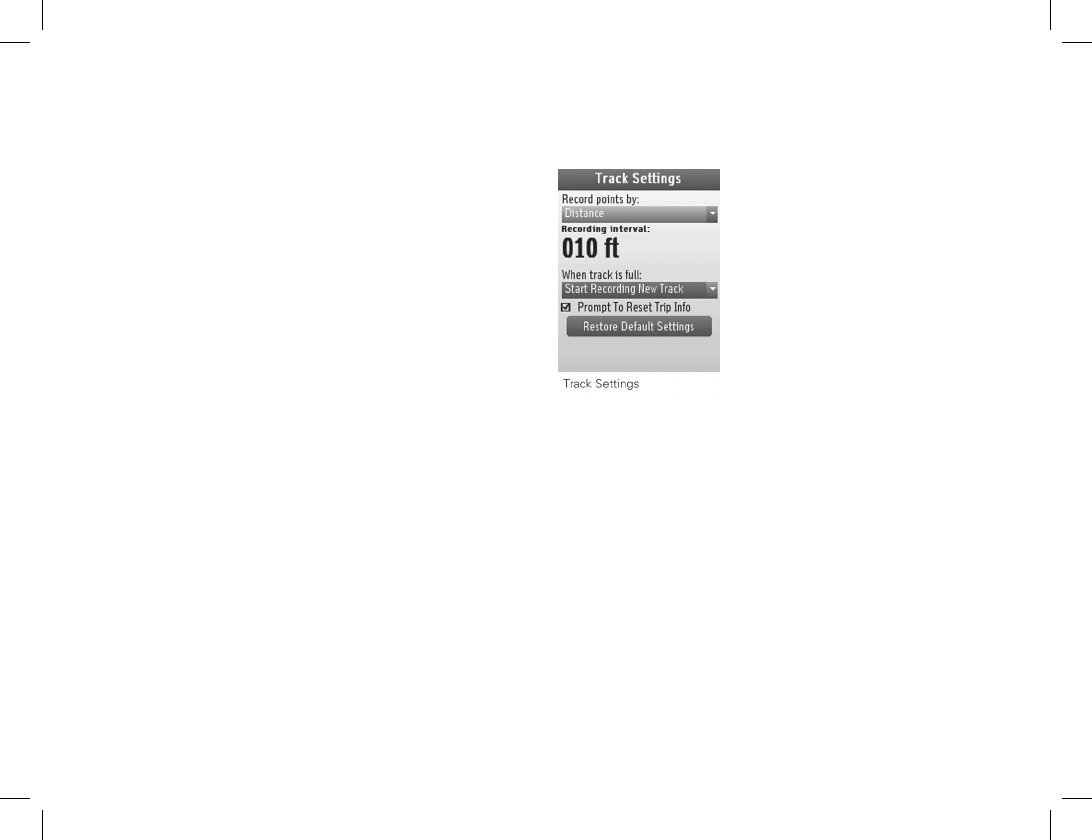
67
The Tracks Page
Track Settings
To customize how tracks are recorded, from the Tracks
Page, go to MENU > Edit Track Settings.
Record points by–The method for logging points;
select Time or Distance from the drop-down list. A
short time interval gives you the most detailed results
but quickly adds many points; logging by distance
gives you a longer recording time.
Recording interval–The amount of time or distance
between each point recording. To edit the number,
highlight it and press ENTER. Use the left/right arrows
on the arrow keypad to select a number and use the
up/down arrows to change it.
When track is full–Determines what the device does
when the maximum number of points (20,000 per
track) is reached.
»Start Recording a New Track–The device saves
the track and starts recording a new track.
»Overwrite Points–The oldest points on the track
are replaced with new points.
»Stop Recording–The device stops recording.
Prompt to Reset Trip Info–When this check box
is selected, the Reset Trip Info page appears when
you manually save or clear an active track. This
synchronizes the Trip Info page with the active track.
To restore the default track settings, select Restore
Default Settings.
Managing Active Tracks
To turn track recording on or off
To turn track recording on, select Record. To stop record-
ing, select Pause.
To clear the active track
To clear the active track, on the Tracks Page, select Clear.
If the Reset Trip Info prompt is turned on in the track
settings, edit the check boxes and select Reset Now, or
press QUIT to exit the page. If track recording is turned
on, a new track will start recording.

68
To follow the active track
To follow the active track back to your starting point, on
the Tracks Page, select Follow. The device creates a
route and the Map Page opens in navigation mode. The
active track continues recording as you follow the track
back to the start.
To prole the active track
To prole the active track, from the Tracks Page, go to
MENU > Prole Active Track. The Prole Page opens.
For more information, see The Prole Page on page 6671.
To view statistics for the active track
To view statistics for the active track, from the Tracks
Page, go to MENU > View Active Track Statistics.
You can view statistics for the entire track or for a section
of the track; use the arrow keypad to scroll through the
statistics pages. For descriptions of the statistics elds,
see the Info Fields Table starting on page 95.
To save the active track
1. Select Save to save the active track as a le and clear
the active track memory.
2. Name and save the le.
3. On the track details page, edit the Track (name),
Color, and Comments elds.
To edit a eld, highlight it and press ENTER. Then, use
the available option (drop-down list, arrow keypad, or
keyboard) to make changes. When you are nished
editing, press ENTER.
4. If the Reset Trip Info prompt is turned on, edit the
check boxes and select Reset Now, or press QUIT to
exit the page.
Managing Track Files
Saved tracks are managed using GPX les; the number of
track les you can save depends on the memory available.
For more information about GPX les, see File Manage-
ment on page 85.
XMap users See the supplemental online help on the
DeLorme Wiki (pnseries.wiki.delorme.com/xmap) for
information about using XMap with the Tracks Page.
File Menu
Use the File menu to manage track GPX les stored in the
PN-60’s internal memory or on an SD card in the device.
To open the File menu, from the Tracks Page, go to
MENU > File. The following options are available:
Open–Open a list of GPX les in internal memory and
on the SD card. Select the le you want to open and
press ENTER to view it on the device.
Close–Close the open GPX le.
The Tracks Page

69
Move to Internal/Move to SD Card–Move the open
le from the current stored location to the alternate
location. For example, you can open a le from an SD
card and move it to the device’s internal memory.
To view details for the open track
Open a saved track le using the File menu. Then, on the
Tracks Page, select Details. The track details page opens.
To edit details for the open track
On a track details page, you can customize the track
name, color, and comments.
To edit a eld, use the arrow keypad to highlight it and
press ENTER. Use the available option (drop-down list,
arrow keypad, or keyboard) to make changes.
To view or hide the open track on the map
The View/Hide button shows the available action. To
view the track on the map, on the track details page,
select View. The track displays on the map using the
color in the Color eld. To hide a track on the map if it is
showing, on the track details page, select Hide.
To follow the open track
To follow a saved track, open the track le and on the
tracks details page, select Follow. The device creates a
route and the Map Page opens in navigation mode.
To play back the open track
While you play back a saved track, the PN-60’s GPS re-
ceiver and active track recording are turned off. You must
turn recording back on once you have nished playing
back the track.
From the track details page, go to MENU > Start Track
Playback. When you see the Track Playback message,
select OK. The Map Page opens and simulates follow-
ing the track. You can access the following settings from
several pages.
To change the track playback speed, go to MENU >
Playback Speed and then select a speed.
To stop track playback, go to MENU > Stop Track
Playback.
The Tracks Page

70
To prole the open track
To prole the open track, from the track details page, go
to MENU > Prole Track. The Prole Page opens. For
more information, see The Prole Page on page 6671.
To view statistics for the open track
To view distance, elevation, speed, and trip statistics for
the open track, from the track details page, go to MENU
> View Opened Track File Stats.
You can view statistics for the entire track or for a section
of the track; use the arrow keypad to scroll through the
statistics pages. For descriptions of the statistics elds,
see the Info Fields Table starting on page 95.
Visit the DeLorme Wiki at wiki.delorme.com for more
information. The latest version of the User Manual is always
available for download.
The Tracks Page

71
A track is a recording of points along the path you travel.
Viewing a prole of a track gives you valuable information
about the track’s elevation—you can view the prole over
track distance or time recorded while traveling. When the
prole changes while you are stationary and tracking by
time, the prole indicates changes in pressure that you
can use to monitor weather changes. The Prole Page
lets you view the elevation of the active track as it is
recording or that of a saved track.
For more information about tracks, see The Tracks Page
section starting on page 66.
Viewing a Prole
You can open the Prole Page from the Home Page
or from the menu on the Tracks Page.
The Prole Page shows two views of the track you are
proling. Press up or down on the arrow keypad to switch
which view is active—the crosshair appears on the
active view.
Detailed–The upper section of the page shows the
section of the track you are viewing. The initial view
shows the track from its start to the current location
(for an active track) or to the nish (for a saved track).
Overview–The bottom section of the page shows
a prole of the entire track.
Time or Distance
You can view the track prole by distance along the track
or by time travelled along the track.
To change the prole method, go to MENU > Switch to
Distance Prole or Switch to Time Prole. The x axis
of the prole graph reects the method.
The Prole Page
The Prole Page

72 The Prole Page
Scale
Switching the type of scale used to measure changes
in elevation gives you different views of the graph.
To change the scale type, go to MENU > Switch to
Static Scale or Switch to Dynamic Scale.
Static–The static scale adjusts the prole graph
based on the maximum and minimum elevation; the
same graph scale is maintained for the entire track,
letting your compare current elevation to the rest of
your trip. This is the default view .
Dynamic–The dynamic scale adjusts based on the
visible maximum and minimum zoom levels. As you
pan the graph or zoom in or out, the graph changes
to give you the best view.
GPS Indicator
The GPS location is indicated by a green dot on the graph
when you are within 100 feet of the track. The dot is in
the center of the crosshair (unless you are panning along
the prole). A red dot indicates there is no GPS x within
100 feet of the track you are proling.
To prole a track
To view a prole for the active track, open the Prole
Page. Track recording must be turned on to view an
active prole.
To view a prole for a saved track, from the Prole Page,
go to MENU > File > Open. Then, select the track le you
want to prole and press ENTER. To close the le, go to
MENU > File > Close.
To switch the track view
To quickly change the track view from the active track to
the open track le, go to MENU > File > Switch to Prole
Active Track/Switch to Prole Opened Track.
To view prole statistics
To view statistical information about the prole, from the
Prole Page, go to MENU > View Prole Statistics.
Use the right and left buttons on the arrow keypad to
scroll through the statistics pages.
Start to Finish–View speed, elevation, and trip
statistics for the entire track.
Start to Cursor–When you have panned along the
track, view speed, elevation, and trip statistics from
the track start to the track point at the cursor location.
Cursor to Finish–When you have panned along the
track, view speed, elevation, and trip statistics from
the track point at the cursor location to the track nish.
Cursor Point Info–When you have panned along the
track, view coordinates, time/date, elevation, grade,
speed, and GPS status for that specic point
on the track.

73
Panning and Zooming
Use the right and left arrows on the arrow keypad to
move the crosshair—or cursor—along the active view
in the prole.
Pan along the track and press ENTER to view that
area on the Map Page. Press QUIT to return
to the prole.
Use the IN button to zoom in to show a smaller
area with more detail.
Use the OUT button to zoom out and show a larger
area with less detail.
When you zoom in or pan to an area on the overview
prole, the detailed prole matches the highlighted
section in the overview.
Info Fields
The info elds that display at the bottom of the Prole
Page depend on your activity and whether you are
navigating or tracking (normal GPS use). To access the
Info Fields options, go to MENU > Info Fields.
For more information, see Info Fields on page 11 and
The Activities Page section on page 17.
Visit the DeLorme Wiki at wiki.delorme.com for more
information. The latest version of the User Manual is always
available for download.
The Prole Page

74
Use the Sun/Moon Page to view the sunrise/sunset and
moonrise/moonset information and the moon phase
information for a specic time, date, and location.
The Sun/Moon Page shows information for the current
map center at the time and date indicated. For example,
if you are in Maine and you pan the map to California, you
see the position of the sun and moon in California for the
time and date displayed.
Sun/Moon graphic
The sun/moon graphic is in the center of the page. The
graphic on the left shows the current position of the sun/
moon in relation to a compass. The gray line represents
a shadow to illustrate the path of the sun overhead.
When the sun is directly overhead in summer months,
the shadow is very short. As winter approaches and the
sun travels lower through the sky the shadow indicator
becomes longer. The graphic on the right shows where
the sun/moon is currently as it moves overhead from
east to west.
Rise/Set
The Rise/Set elds display the time that both the sun (left)
and moon (right) will rise and set. If the sun or moon does
not rise or set on a specic date, dashes (- -) display in the
applicable information elds.
Moon Phase
The Phase eld displays the name of the current moon
phase, the percentage completed if it's waxing or waning,
and a graphic representation of the phase.
To change the location
To view information for a location other than your current
GPS location, change the map center (for example, by
The Sun/Moon Page
The Sun/Moon Page

75
The Sun/Moon Page
panning the map or viewing a waypoint). Then, open the
Sun/Moon Page from the Home Page.
To change the time and date
You can change the time and date to see different sun/
moon information.
1. Highlight the eld you want to edit (Time or Date).
2. Press ENTER and use the arrow keypad to make
changes. When you are nished editing, press ENTER.
To reset the time and date
If you change the time and date on the Sun/Moon Page,
you can reset it to the device’s time and date.
From the Sun/Moon Page, go to MENU > Reset
Time/Date.
Visit the DeLorme Wiki at wiki.delorme.com for more
information. The latest version of the User Manual is always
available for download.
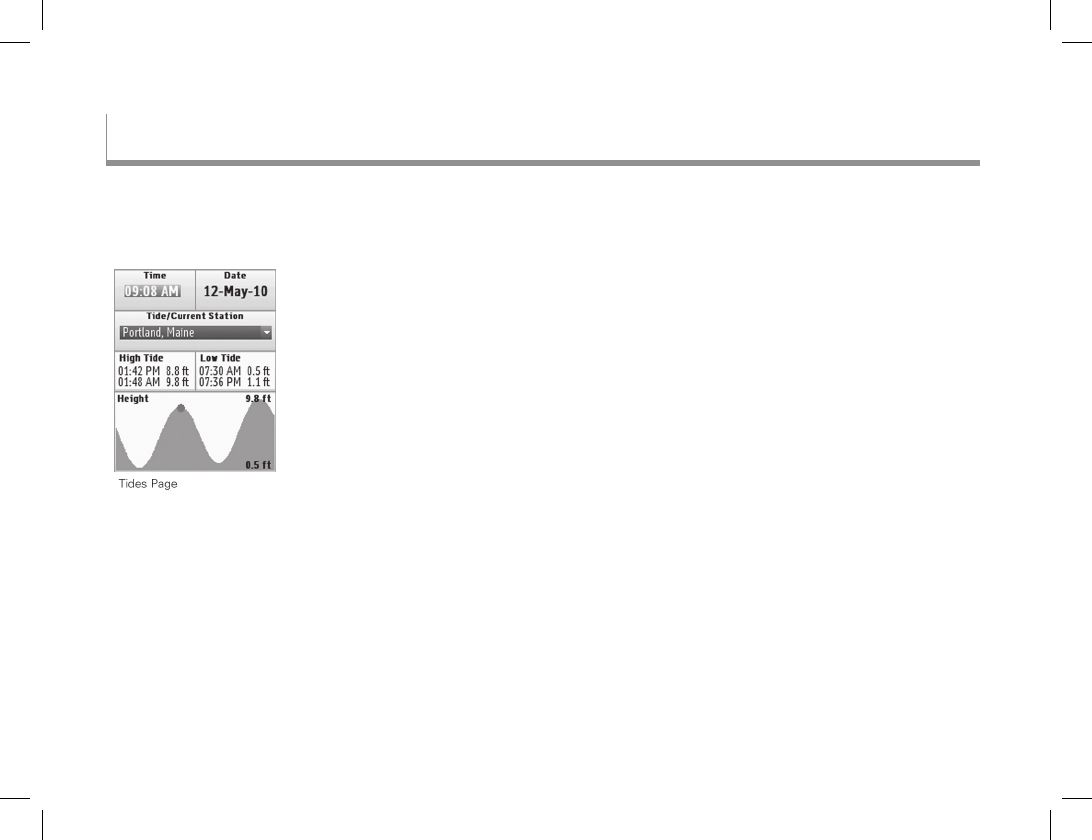
76
Use the Tides Page to view tide (for oceans) or current
(for tidal rivers) information for a specic time, date, tide
station, and location.
The elds in the middle of the screen (above the graph)
display the high/low tide (ocean) or maximum ebb/minimum
ood current (tidal river) based on the current time, date,
and location.
The graph at the bottom of the screen shows the
tide/current information for a 24-hour period. The red
dot in the graph represents the tide/current based on the
time and date selected.
To change the location
To view information for a location other than your current
GPS location, change the map center (for example, by
panning the map or viewing a waypoint). Then, open
the Tides Page from the Home Page.
The information for the closest tide station displays and
the ten tide stations closest to the map location are
available in the Tide/Current Station drop-down list.
To change the tide station
Select the tide station from the Tide/Current Station
drop-down list; the ten stations closest to the current
map center are listed.
To change the time and date
You can change the time and date to see different tide/
current information.
1. Highlight the eld you want to edit (Time or Date).
2. Press ENTER and use the arrow keypad to
make changes. When you are nished editing,
press ENTER.
The Tides Page
The Tides Page

77
To reset the time and date
If you change the time and date on the Tides Page,
you can reset it to the device’s time and date.
From the Tides Page, go to MENU > Reset Time/Date.
Visit the DeLorme Wiki at wiki.delorme.com for more
information. The latest version of the User Manual is always
available for download.
The Tides Page

78
Use the Hunt/Fish page to view a prediction of the
hunting and shing conditions for a specic day and
location. The calculations are based on John Alden
Knight’s Solunar Tables, which use the cycle of the sun
and moon to predict activity and feeding schedules.
To change the location
The coordinates shown on the Hunt/Fish Page are for
the current map center. To view information for a location
other than your current GPS location, change the map
center (for example, by panning the map or viewing a
waypoint). Then, open the Hunt/Fish Page from the
Home Page.
To change the date
You can change the date to see a prediction of the hunting
and shing conditions for a specic day.
When you view the Hunt/Fish Page, the Date eld is
highlighted; press ENTER and use the arrow keypad
to make changes. When you are nished editing,
press ENTER.
To reset the date
To reset the date to the device’s date, from the Hunt/Fish
Page, go to MENU > Reset Date.
Visit the DeLorme Wiki at wiki.delorme.com for more
information. The latest version of the User Manual is always
available for download.
The Hunt/Fish Page
The Hunt/Fish Page

79
Use the Settings Page options to modify the default
settings on the PN-60.
System
Use the System options to modify GPS/WAAS settings,
select the battery type, turn USB power on or off, and
view and manage memory information.
To change system settings
From the Settings page, select System, and then select
the option you want to change.
GPS Setting–From the drop-down list, select the
GPS option to use.
»Normal–Normal GPS use.
»Power Saving–Several settings are changed to
optimize battery performance.
The screen backlight is turned off after 15 seconds.
The GPS updates less often and WAAS is turned off.
If the accelerometer detects no motion, the GPS
is turned off after 30 seconds.
The device goes into “doze mode” after 30
seconds. To wake up the PN-60, move it or press
any button.
»Off–Turns off GPS satellite tracking. See To turn off
GPS on page 19.
»Demo Mode–Turns Demo Mode on or off. See
To view or hide Demo Mode on page 7.
Sleep when Stationary–Select the check box to put
the device in doze mode when it is stationary for more
than 60 seconds.
Stealth Mode–Select this check box to set sounds
to Mute All and the backlight to Always Off.
WAAS–From the drop-down list select On to use
WAAS or Off if you don’t want to use it. See GPS
and WAAS Status on page 18.
Battery Type–From the drop-down list, select
Alkaline, Lithium, NiMH, or Li-ion (Rechargeable);
See Batteries and SD Card on page 6. You must
manually change the battery type when changing the
type of battery you use to ensure the battery charge
indicator displays correctly.
Note about Li-ion batteries Use only DeLorme
Li-ion batteries. When you remove a Li-ion battery,
the Battery Type will switch automatically to Lithium.
USB Power–From the drop-down list, select On to
The Settings Page
The Settings Page
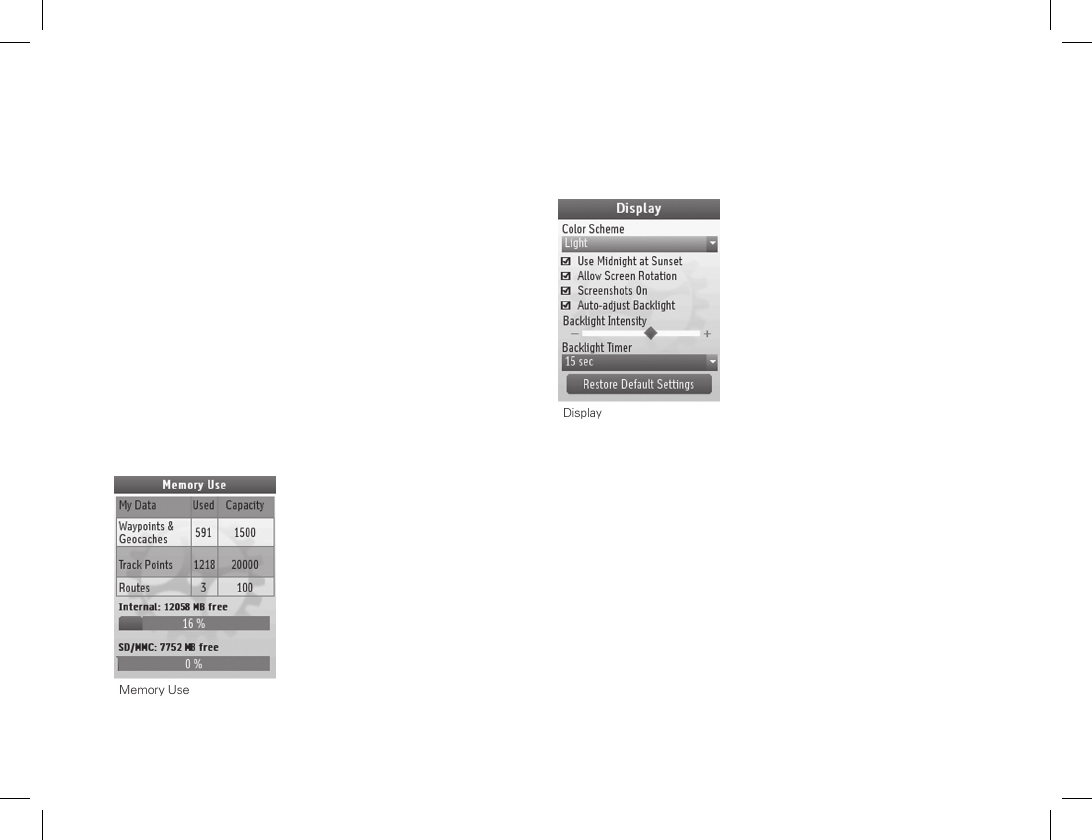
80
allow the device to be powered by a USB port on
your computer. Select Off if you don’t want to
allow USB power.
To view memory use
You can view how much space is available on the device's
internal memory or an SD card in the device.
From the Settings Page, go to System > Memory Use
to view:
Internal memory use
SD card memory use
The number of waypoints/geocaches, tracks, and
routes open on the device.
The device's total capacity for storing waypoints/
geocaches, tracks, and routes.
Display
Use the Display options to update the device’s color
scheme and backlight settings.
To change display settings
From the Settings Page, select Display, and then select
the option you want to change.
Color Scheme–From the drop-down list, select
the color scheme (Light, Dark, or Midnight).
Note The Midnight option uses the Dark color
scheme with a high-contrast map.
Use Midnight at Sunset–Select this check box to
automatically switch to the Midnight color scheme
between sunset and sunrise.
Allow Screen Rotation–Select this check box if you
The Settings Page

81
want the screen to rotate when you view the device
upside down. When rotated, the arrow keypad adjusts
to match the device’s orientation.
Screenshots On—Select the check box to take a
screen capture when you press and hold the Power
button and then press ENTER. A sound plays to
conrm the screenshot. For more information about
screenshots, see Taking a Screenshot on page 10.
Auto-adjust Backlight–Select this check box if you
want the device to automatically adjust the backlight
based on the available light. If you manually change
the backlight, the check box is cleared.
Backlight Intensity–Use the arrow keypad to move
the slider to the right or left to increase or decrease
the intensity of the backlight. You can also access the
backlight setting using the Power button; see Power
on page 8.
Backlight Timer–From the drop-down list, select the
amount of time the backlight stays on before it dims
to save power or select Always On or Always Off.
Connect to Computer
Use the Connect to Computer options to determine
what mode the device is in when you connect it to your
computer with the USB cable.
To change the connection settings
From the Settings Page, select Connect to Computer,
and then select the option you want to change.
When Connected–From the drop-down list, select
the connection method the device will use when you
connect it to your computer.
»Use GPS–Use this option if you are using a
compatible DeLorme mapping program or Cache
Register™ to sync your device—the program will
automatically put the device in the correct transfer
mode. This also allows you to use the device as
an external GPS; for example, with a laptop.
»Open SD Card–Allows you to view an SD card in
the device as a drive for manual le management.
»Open Internal Drive–Allows you to view the
device’s internal memory as a drive for manual le
management.
Use XMap 7 Mode–Allows you to use a PN-60
with XMap. For specifc information about le
management with XMap, visit the Delorme Wiki
(pnseries.wiki.delorme.com/xmap).
Use Serial Port–Select the check box to use a
serial port connection for NMEA out only.
The Settings Page

82
Compass and Altimeter
Use the Compass & Altimeter options to activate or
deactivate the electronic compass, the barometric altimeter,
and the auto calibrate altimeter feature. You can also calibrate
the electronic compass and the barometric altimeter.
For more information, see Compass and Altimeter
starting on page 86.
To change compass and altimeter settings
From the Settings Page, select Compass & Altimeter,
and then select the option you want to change.
Select the check box next to an option to activate it.
Use Electronic Compass–If this is not selected,
the device uses the GPS compass.
Use Barometric Altimeter–If this is not selected,
the device uses the GPS elevation.
Auto Calibrate Altimeter–Allows the altimeter
to automatically calibrate.
To calibrate the compass or altimeter
From the Settings Page, go to Compass & Altimeter >
Calibrate, select Calibrate Compass or Calibrate
Altimeter, and then follow the on-screen instructions.
Wireless
PN-60w only
The wireless options allow you to turn the wireless
antenna on and off and to pair your SPOT Communicator
with the PN-60w.
Wireless Antenna On—Select the check box to turn
the wireless antenna on. Clear it to the turn
the antenna off.
Pair Communicator—Select this option to pair the
PN-60w and the SPOT Communicator. The SPOT
Communicator Setup page opens.
Sound
The Sound options control sounds and volume.
To modify the sound settings
From the Settings Page, select Sound, and select the
The Settings Page

83
option you want to change.
From the drop-down list for each of the following
options, select the sound you want to use or turn it
off.
»Sounds
»Button Press
»Message
»Power
»Turn Alert
Volume–To adjust the volume, use the arrow keypad
to move the slider right or left.
Time
Use the Time options to modify the device’s time format,
time zone, and Daylight Saving Time preferences.
To modify the time settings
From the Settings Page, select Time, and then select
the option you want to change.
Time Format–From the drop-down list, select Local
12 hr or Local 24 hr.
Zone–From the drop-down list, select your actual
time zone or select Automatic to allow the device
to update the time based on your GPS location.
Use Daylight Saving Time–Select the check box
to adjust the time for Daylight Saving Time.
Units
Use the Units option to set the units of measure for
the device.
To modify the units settings
From the Settings Page, select Units, and then select
the option you want to change.
From the drop-down list for each of the options, select
the unit of measure you want to use:
Coordinates: Primary–Degrees; Degrees, Minutes;
Deg, Min, Sec; UTM/UPS; or USNG/MGRS.
Datum: Primary–Various. The default datum
is WGS84.
Coordinates: Secondary–UTM/UPS; Degrees;
Degrees, Minutes; Deg, Min, Sec; or USNG/MGRS.
Datum: Secondary–Various.
Measures–Statute Miles, Kilometers, Nautical Miles/
Feet, or Nautical Miles/Meters.
Pressure– Inches of Mercury, Millibars, or Pascals.
Bearing–True or Magnetic. True represents the
true location of the North Pole. Magnetic sets the
device to use magnetic bearings; this is useful when
comparing the device with a digital compass for use
with maps that have magnetic declination built into
the map grid.
The Settings Page

84
Note The Coordinates: Primary setting controls what the
device displays on the map when the cursor moves. The
Coordinates: Secondary eld lets you pick a different
setting to use in an info eld.
Page Order
You can change which pages display when you press the
PAGE button and the order in which they display. You
cannot remove the Map Page from the PAGE button order.
To modify the PAGE button order
From the Settings Page, select Page Order.
To add a page, select the check box next to it.
To remove a page, clear the check box next to it.
To change the page order, highlight the item you want
to move, then use the arrows on the right side of the
screen to move the page up or down in the list.
Owner Information
Use the Owner Information screen to enter text that
identies your device.
To enter owner information, go to Settings > Owner
Information and edit the text area.
To display the information when you turn on your device,
select the Display Info at Startup check box. The Owner
Info screen displays after the Welcome screen.
About this Device
To view the serial number for downloading maps and the
build/version number for the device's rmware, go to
Settings > About this Device. To view license
information, highlight License and press ENTER.
Restore Default Settings
To restore all of the Settings Page options at the same
time, go to Settings > Restore Default Settings. To
restore default settings for a specic options page, select
Restore Default Settings on that page.
Restore Factory Settings
To reset all the settings on your device to the "out-of-the-
box" status and delete all tracks, routes, waypoints, and
geocaches in memory, go to Settings > Restore Factory
Settings. Maps you have added to the device will
not be deleted.
Visit the DeLorme Wiki at wiki.delorme.com for more
information. The latest version of the User Manual is always
available for download.
The Settings Page

85
File Management
Waypoints (including geocaches) and tracks are managed
using GPX—or GPS Exchange Format—les. A GPX le
stores location, elevation, and time information and is
used to transfer data between your PN-60 and your
computer. GPX les can be saved to the PN-60’s internal
drive or on an SD card that you put in the device.
Tip On the Waypoints, Geocaches, Tracks, and Prole
pages, press MENU and select File to view the available le
management options. For more information about the options
available on each page, see that section of the manual.
Creating a New GPX File on the PN-60
When you save a track, a GPX le is created.
When you mark a waypoint or geocache, if a waypoint
le is open, the new waypoint is saved to the open
le. If a waypoint le is not open, a new le is created.
Syncing GPX Files
Earthmate® GPS Sync—With DeLorme Topo North
America™ 9.0, you can quickly send GPX les from
your desktop to the PN-60’s internal memory or an
SD card that is in the device or in an SD card reader.
When you return from your trip, you can send les
back to the desktop to keep all your data in sync.
For more information about Earthmate GPS Sync,
see the Help in DeLorme Topo North America 9.0.
DeLorme Cache Register™–Use Cache Register
to sync Geocaching.com Pocket Query GPX les
with your device. For more information, see The
Geocaches Page section starting on page 53.
Manual Transfer—If you are not using DeLorme
Topo North America, on the device go to Settings >
Connect to Computer > When Connected > Open
SD Card or Open Internal Drive. Then, connect the
PN-60 to your computer with the USB cable and drag
and drop GPX les into the Waypoints or Tracks folder.
You can also use an SD card with an SD card reader.
Transferring Map Files
With Earthmate GPS Sync in DeLorme Topo North America,
you can send map packages between your desktop and
the PN-60’s internal memory or to an SD card in the
device or in an SD card reader.
Additional Information
Additional Information
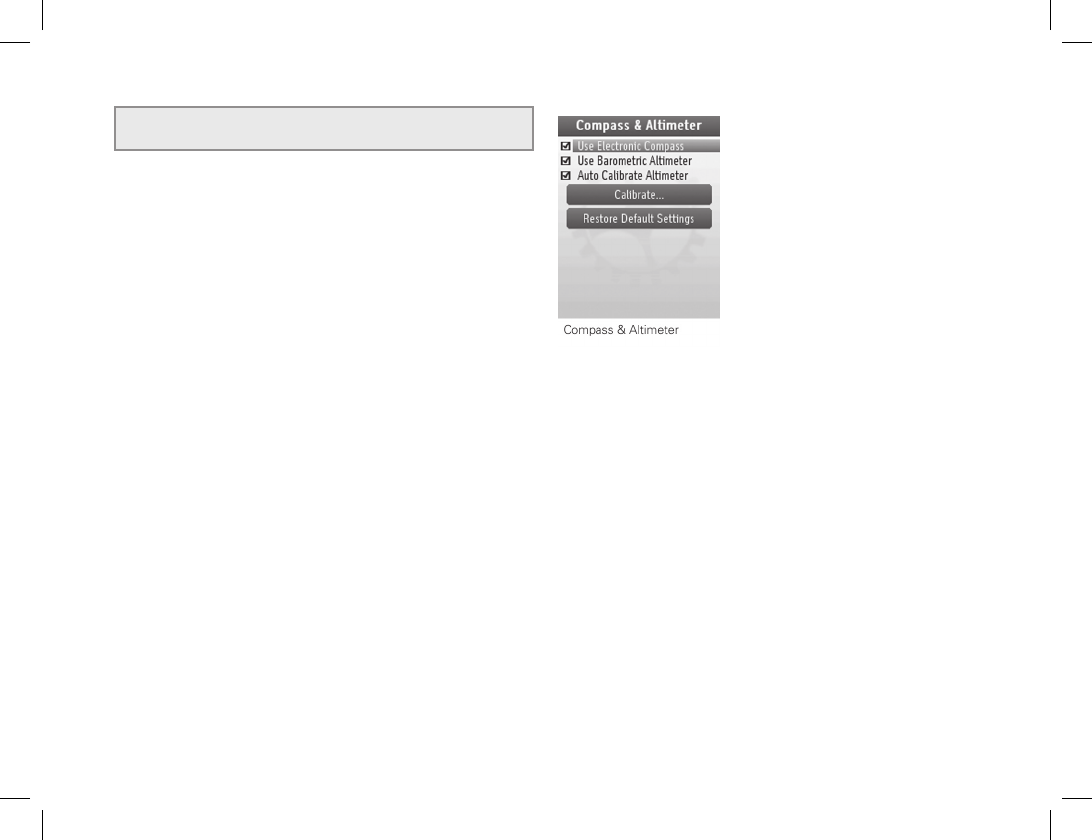
86
Tip Use the SD card reader to quickly transfer large maps.
Send maps you use frequently to the device’s internal memory.
Compass and Altimeter
The PN-60 comes equipped with two sensors; an
electronic compass and a barometric altimeter.
The electronic compass works when the PN-60 is
moving at less than 1.5 miles per hour. The compass
readings calculated from GPS information are accurate
only when the device is moving.
The barometric altimeter uses the elevation adjusted
to mean sea level and barometric pressure to provide
more accurate elevation readings than the calculated
GPS elevation provides.
Changes in weather patterns and geographic locations
can cause errors in sensor readings. Calibrating the
sensors ensures that they record and display accurate data
on the device and record accurate data in the track le.
The Calibrate option is available from the Satellite Page
and the Compass Page, and is under the Compass
& Altimeter option on the Settings Page.
In addition, from the Settings > Compass & Altimeter
menu, you can enable or disable the electronic compass,
barometric altimeter, and the auto-calibrate barometer
options, or restore the default settings.
Compass Calibration
Calibrate the electronic compass the rst time
you use the PN-60.
Make sure you are outside and away from magnetic
elds, such as those caused by vehicles and power
lines, when you calibrate the compass.
Calibrate when you change the batteries—batteries,
even of the same type, have unique magnetic elds
that affect the accuracy of the electronic compass.
The device periodically checks the compass
accuracy; if it is poor, “Poor Accuracy” appears
in the bottom right corner of the Compass Page and
a red exclamation point displays in the Heading info
eld. If the warning does not go away, try calibrating
the compass.
Additional Information

87
To calibrate the compass
1. From the Satellite Page or the Compass Page,
go to MENU > Calibrate > Calibrate Compass.
OR
From the Home Page, go to Settings > Compass
& Altimeter > Calibrate > Calibrate Compass.
2. Follow the on-screen instructions to calibrate
the compass.
Altimeter Calibration
There are three options for calibrating the altimeter.
By default, the device is set to auto-calibrate the altimeter
using GPS elevation; however, manual calibration using
the known elevation or barometric pressure provides
greater accuracy.
Auto-calibration uses the average GPS elevation as a
basis for the barometric elevation. Adjustments are made
to take into account changes over time in the barometric
pressure, unrelated to changes in elevation. As the
elevation adjusts (typically in 2-3 minutes), "Calibrating"
displays in the bottom right corner of the Satellites Page.
If you are using the Elevation: Barometer info eld on any
page, it displays a red exclamation point.
Note that the unit settings used in the Known Elevation
and Known Pressure elds are from the units set on
your device. To change the units, go to Settings >
Units > Pressure.
To calibrate the altimeter
1. From the Satellite Page or the Compass Page,
go to MENU > Calibrate > Calibrate Altimeter.
OR
From the Home Page, go to Settings > Compass
& Altimeter > Calibrate > Calibrate Altimeter.
2. Select a calibration method.
»Known Elevation–The actual elevation
at your location.
»Known Pressure–The barometric pressure
(adjusted for sea level) for your location.
»GPS Elevation–The GPS elevation calculated
by the device.
Additional Information

88
3. If you selected Known Elevation or Known Pressure;
to edit the eld, press ENTER and use the arrow
keypad to make changes. When you are nished
editing, press ENTER.
4. Select Calibrate, and when you see the successful
calibration message, press ENTER.
Resources
DeLorme
DeLorme Wiki (wiki.delorme.com)
DeLorme website (delorme.com)
DeLorme Community Forums (forum.delorme.com)
The DeLorme Weblog (blog.delorme.com)
SPOT Communicator
SPOT website (ndmespot.com)
Contact Information
DeLorme Technical Support
Visit support.delorme.com to access the DeLorme Technical
Support Knowledge Base, get answers to frequently
asked questions, and for additional support information.
If you cannot nd an answer to your problem on the site,
please call 207-846-8900 to speak to a Technical Support
representative. Please note that DeLorme Technical
Support does not provide product training.
DeLorme Customer Service
For general questions about returns, your order status, or
problems with shipments, phone 800-511-2459 (Monday
through Friday) or send an email to sales@delorme.com.
To place additional orders, phone 800-561-5105.
SPOT Communicator
For questions about the device, call DeLorme Customer
Service. For questions about SPOT products and services,
visit ndmespot.com.
Service Plan
Before a product can be returned, you must contact
DeLorme Support at 207-846-8900 to determine if
a return is necessary and request a Return Material
Authorization (RMA) tracking number.
The following information must be provided to obtain
warranty service:
A copy of the sales receipt from the original retailer
The serial number of the device
The RMA tracking number that you received when
you called DeLorme
Your return shipping address
Your daytime telephone number
Additional Information

89
If you have contacted DeLorme Technical Support and
have been instructed to send the device in for warranty
service, send the unit to:
DeLorme Earthmate PN-Series
Service Department
2 DeLorme Drive
Yarmouth, ME 04096 USA
You must use a shipping service that provides tracking
information. For the latest warranty and repair
information, visit delorme.com/gpsrepair.
Specications
Earthmate PN-60/PN-60w
Physical Specications
Case: IPX-7 waterproof, impact resistant, and rugged
Size: 5.25" x 2.43" x 1.5"
Weight: 5.35 oz (without batteries)
Technical Specications
Hardware
Super high-sensitivity 32-channel Cartesio chipset
by STMicroelectronics
Dual-core processor
WAAS-enabled; position accuracy < 3 meters
Cold start: < 1 minute; warm start: < 45 seconds;
hot start: 5-6 seconds
Maximum Velocity: 1000 knots
Advanced high-sensitivity tracking algorithms
Weak signal tracking down to -159dBm
Proprietary Kalman lter for enhanced position
accuracy
Superior noise rejection for high electromagnetic
interference environments
Operating temperature range:
-4ºF to +167ºF (-20ºC to +75ºC)
Storage temperature range:
-49ºF to +212ºF (-45ºC to +100ºC)
3-axis electronic compass with accelerometer
Barometric altimeter
Built-in antenna
Sharp high-resolution 2.2" Transective TFT color
display (220 x 176 pixels)
Audio: Button presses, directions, and alerts
Map and User Data
Detailed U.S. and Canadian base map data with second-
ary and connector roads along with major highways and
roads for the entire world.
Power and Memory
Power (without SD card):
» Full power: 17 hours with 2 AA alkaline batteries;
29 hours with 2 AA Lithium batteries
Additional Information

90
[450mW typical (600mW with full backlight)]
» Power save: 30 hours with 2 AA alkaline batteries;
50 hours with 2 AA Lithium batteries [< 270mW]
Fast USB 2.0 data transfer
3.5 GB available internal ash memory
(SE model: 15.5 GB available internal ash memory)
Supports SD and SDHC memory cards; up to 32 GB
Uses 2 AA batteries or a DeLorme Li-on rechargeable
battery.
PN-60w Wireless Radio
Radio Technology: IEEE 802.15.4 compliant
Transmitter Bit Rate: 250kb/sec (maximum)
Frequency Spectrum: 2.4GHz unlicensed band
Transmitter Power (peak): 10mW
Operating Temperature Range:
-4ºF to +167ºF (-20 ºC to +75ºC)
Storage Temperature Range:
-49ºF to 212 ºF (-45ºC to +100ºC)
Active memory holds 20,000 track points:
1,500 waypoints; 100 routes
FCC Certication
This equipment has been tested and found to comply
with the limits for a class B digital device, pursuant to Part
15 of the FCC rules. These limits are designed to provide
reasonable protection against harmful interference in a
residential installation. This equipment generates, uses,
and can radiate radio frequency energy and, if not installed
and used in accordance with the instructions, may cause
harmful interference to radio communications. However,
there is no guarantee that interference will not occur in a
particular installation. If this equipment does cause
harmful interference to radio or television reception,
which can be determined by turning the equipment off
and on, the user is encouraged to try to correct the
interference by one or more of the following measures:
Reorient or relocate the receiving antenna.
Increase the separation between the equipment and
the receiver.
Connect the equipment into an outlet on a circuit
different from that to which the receiver is connected.
Consult the dealer or an experienced radio/TV
technician for help.
Cautions and Warnings
Any changes or modications not expressly approved by
the grantee of this device could void the user’s authority
to operate the equipment.
FCC RF Radiation Exposure Statement
This equipment complies with FCC RF radiation
Additional Information

91
exposure limits set forth for an uncontrolled environment.
This equip-ment should be installed and operated with
a minimum distance of 20 cm between the radiator
and your body.
CAUTION Danger of explosion if battery is incorrectly
replaced. Replace only with the same or equivalent type
recommended. Dispose of used batteries according to
the manufacturer’s instructions.
WARNING Do not damage the rechargeable Lithium-ion
battery. A damaged battery can cause an explosion or re,
and can result in personal injury and/or property damage.
Limited Warranty
DeLorme warrants that your Earthmate PN-60 GPS will
be free from defects in materials and workmanship for
1 year from the date of purchase. If your Earthmate PN-60
GPS fails in normal use, DeLorme will, at its sole option,
either repair or replace the unit. DeLorme reserves the
right to either repair or replace the unit with a new
or refurbished unit at its sole discretion.
Such repairs or replacements will be made at no charge
for labor or materials; however, the customer will be
responsible for any shipping charges incurred to send
the device to DeLorme. The repaired or replaced product
will be warranted for 90 days from the date of return
shipment, or for the balance of the original warranty,
whichever is longer. This warranty does not cover
failures due to abuse, misuse, accidents, or unauthorized
disassembly or modication. Any repairs not performed
by DeLorme will void this warranty.
DELORME DISCLAIMS ANY LIABILITY FOR ANY
SPECIAL, INDIRECT, INCIDENTAL, OR CONSEQUENTIAL
DAMAGES, INCLUDING, BUT NOT LIMITED TO, LOSS
OF REVENUES OR PROFITS, EVEN IF DELORME HAS
BEEN ADVISED OF THE POSSIBILITY OF SUCH DAMAGES.
THIS LIMITED WARRANTY CONTAINED HEREIN IS IN
LIEU OF ALL OTHER EXPRESS WARRANTIES. ANY
AND ALL IMPLIED WARRANTIES, INCLUDING ANY
IMPLIED WARRANTIES OF MERCHANTABILITY OR
OF FITNESS FOR A PARTICULAR PURPOSE, SHALL
LAST FOR 1 YEAR.
This warranty gives you specic legal rights and you may
also have other rights which vary from state to state.
Some states do not allow the exclusion or limitation of
relief such as incidental or consequential damages, or
limitations on how long an implied warranty lasts, so the
above limitations or exclusions may not apply to you.
This warranty applies to the original purchaser of
the product ONLY.
Additional Information

92
REMINDER Be sure to retain the sales receipt proving
the date of your original purchase. This will be needed if
warranty service is ever required. DeLorme reserves the
right to refuse warranty if a receipt is not provided or if the
receipt is incomplete/illegible.
Copyright Information
Fonts
» Contains iTypeTM and FelbridgeTM Condensed from
Monotype Imaging Inc. Monotype® is a trademark
of Monotype Imaging Inc. registered in the United
States Patent and Trademark Ofce and may
be registered in certain jurisdictions. Felbridge
is a trademark of Monotype Imaging Inc. and
may be registered in certain jurisdictions.
» Some fonts used are derived from the DejaVu fonts,
which are derived from Bitstream Vera, Copyright
2003 by Bitstream, Inc. All Rights Reserved.
Geocaching icons (Copyright © Groundspeak Inc.)
used with permission.
Specications
SPOT Communicator
Physical Specications
Case: IPX-7 waterproof, impact resistant, and rugged
Size: 2.6" x 3" x 1.25"
Weight: 3.7 oz.
Battery Life and Usage
Use only AA Lithium batteries in your SPOT Communicator.
Alkaline or other battery technologies, including
rechargeable batteries, are not recommended. In an
emergency situation, if you have access to alkaline or
other battery technologies, the SPOT Communicator
might work but will not offer the specied battery life
or performance.
Power
SOS mode: Up to 7 days of messages
Type & Send mode: Up to 5 days of messages
Track Progress mode: Up to 10 days of messages
Standby mode: Up to 4 months
Operational and environmental conditions can decrease
the battery life achieved under normal usage conditions.
See ndmespot.com for more details regarding
battery life.
Additional Information

93
Operating Conditions and Specications
The SPOT Communicator must have an unobstructed
view of the sky, either outdoors or in a glass enclosed
area, such as a vehicle dashboard or sunroof. Visit
ndmespot.com for more detailed information.
Coverage
SPOT works around the world, including virtually all of
North America, Europe, Australia, and portions of South
America, Africa, and Asia, as well as hundreds
or thousands of miles off shore of these areas. It is
important that you check coverage for your destination at
ndmespot.com before traveling.
Premium SMS Service
Additional charges may apply in some regions. Standard
text messaging charges from your mobile phone
provider may also apply. Visit ndmespot.com for
more information.
Troubleshooting
The SPOT Communicator performs a self-diagnostic test
each time it is powered on. SPOT recommends that you
send and verify a Check-in/ OK message before each trip.
This also allows you to evaluate your entire messaging
system—from the operational condition of the SPOT
Communicator to the readiness of those on your contact
list. See the FAQ section on ndmespot.com for more
information.
Limited Warranty
Spot LLC warrants that your SPOT Satellite Communicator
will be free from defects in materials and workmanship
for a warranty period of 1 year from the date of purchase.
If your SPOT Communicator fails in normal use, Spot LLC
will, at its sole option, either repair or replace the unit
with a new or refurbished comparable unit at no charge
for labor and materials; however, the customer will be
responsible for shipping charges. New or refurbished
parts may be used for repairs and replacements. Repaired
or replaced product will be warranted for the balance of
the original warranty. The warranty does not cover failures
due to abuse, misuse, accidents, or unauthorized disas-
sembly or modication or any damage sustained
during shipment of the product. Spot LLC has no
responsibility for any warranty claims made after the
1 year limited warranty expires.
EXCEPT AS PROVIDED ABOVE, THE PRODUCT IS
SOLD “AS IS” WITHOUT ANY EXPRESS OR IMPLIED
WARRANTIES FOR THE PRODUCT, INCLUDING,
WITHOUT LIMITATION, ANY IMPLIED WARRANTIES
REGARDING THE CONDITION, DESIGN, SPECIFICATIONS,
Additional Information

94
WORKMANSHIP, MERCHANTABILITY OR FITNESS FOR
A PARTICULAR PURPOSE OF THE PRODUCT, OR ANY
WARRANTIES THAT THE PRODUCT IS FREE FROM
LATENT DEFECTS OR DEFICIENCIES, OR THAT THE
PRODUCT IS FREE FROM INFRINGEMENT OF ANY
PATENT, TRADEMARK, COPYRIGHT OR PROPRIETARY
RIGHT OF ANY THIRD PARTY AND SUCH WARRANTIES
ARE EXPRESSLY DISCLAIMED. THIS LIMITED
WARRANTY PROVIDES THE SOLE AND EXCLUSIVE
REMEDY FOR ANY DEFECTS IN THE PRODUCT. IN
NO EVENT SHALL WE BE LIABLE FOR ANY INDIRECT,
CONSEQUENTIAL, SPECIAL, INCIDENTAL OR PUNITIVE
DAMAGES, WHETHER IN CONTRACT, TORT,
NEGLIGENCE, STRICT LIABILITY OR OTHERWISE.
OUR LIABILITY IS LIMITED TO THE AMOUNT YOU
PAID FOR THE PRODUCT THAT IS THE SUBJECT OF
A CLAIM. THE APPLICABILITY OF THE ABOVE
LIMITATIONS AND EXCLUSIONS MAY VARY
FROM STATE TO STATE.
FCC/IC Notice
This equipment has been tested and found to comply
with the limits for a Class B digital device, pursuant to
Part 15 of the FCC Rules. Operation is subject to the
following two conditions: (1) This device may not cause
harmful interference, and (2) this device must accept any
interference received, including interference that may
cause undesired operation. This device complies with
the requirements for radio astronomy site avoidance as
specied by the Globalstar National Science Foundation
agreement of 2001. It is compliant with CFR 25.213.
This device automatically adjusts to transmission
frequency according to its location and is compliant
with international regulatory requirements.
This Class B digital apparatus complies with
Canadian ICES-003.
Certications
ROHS and WEEE compliant
Certied to FCC and CE emissions, immunity, and
safety regulations.
Meets FCC part 25 regulations, Canada type approval,
CISPR Publication 22 (1985 1st edition), RTTE Directive
(1999/EC), and IEC 60950 safety standard.
Visit ndmespot.com for the latest certication
information.
Spot LLC (ndmespot.com) is not afliated with Spot
Image (spotimage.com).
Additional Information

95
Info elds are used to provide information you need when using the PN-60. On the Map, Compass, Trip Info, and Prole
Pages, you can customize the info elds. For more information, see Info Fields on page 11.
Notes
Info eld labels may be abbreviated; for example, Velocity Made Good is labeled VMG.
Time is expressed as hours:minutes AM/PM. Go to Settings > Time to change the time format (12 hour/24 hour)
and to turn Daylight Saving Time on or off.
Dates are expressed as day-month-year (for example, 01-JUL-10).
When information is unavailable, the info eld contains dashes.
You can change the unit of measure for many info elds; the location on the Settings Page for changing the settings
is indicated. For more information, see The Settings Page section on page 79.
Info Field Description
Back on Course The direction of travel needed to return to the route while continuing in the
direction of the destination; expressed in degrees. (Units > Bearing)
Battery Life The percentage of battery power that remains. (System > Battery Type)
Bearing The direction of travel from the current location to the destination (nish or next
stop); expressed in degrees. A green arrow points in the direction of the next
waypoint or route point.
The arrow is green when the device is moving and gray when no movement
is detected. (Units > Bearing)
Info Fields Table
Info Fields Table

96
Info Field Description
Coordinates: Primary The primary coordinates format for the current GPS location, cursor position, or
map center in the primary format. The default is Lat/Lon. (Units > Coordinates:
Primary)
Coordinates: Secondary The secondary coordinates format for the current GPS location, cursor position,
or map center in the secondary format. The default is UTM/UPS. (Units >
Coordinates: Secondary)
Course The direction of travel on a route from the starting location to the destination
(nish or next stop); expressed in degrees. (Units > Bearing)
Device Odometer The total distance traveled in all trips. (Units > Measure)
Distance: Climbing Prole Page only. The cumulative linear distance spent in increasing elevation.
(Units > Measure)
Distance: Descending Prole Page only. The cumulative linear distance spent in decreasing elevation.
(Units > Measure)
Distance: Linear Prole Page only. The cumulative linear distance from the start to the point of
reference, not taking into account distance caused by elevation changes.
(Units > Measure).
Distance: Terrain Prole Page only. The cumulative distance along the ground, including any
distance increases caused by changes in elevation. (Units > Measure)
Distance to Finish The distance from the current location to the route nish. (Units > Measure)
Distance to Next Stop The distance from the current location to the next stop in the route. (Units >
Measure)
Info Fields Table

97
Info Field Description
Distance to Next Turn The distance from the current location to the next turn in the route. (Units >
Measure)
Elevation The altitude (height) above or below sea level. (Units > Measure)
Elevation: Barometer The altitude (height) above or below sea level based on the barometric altimeter
reading. If the altimeter is calibrating, a red exclamation point displays. (Units >
Measure)
Elevation: Climbing Prole Page only. The cumulative elevation gained while climbing; expressed in
distance. (Units > Measure)
Elevation: Descending Prole Page only. The cumulative elevation lost while descending; expressed in
distance. (Units > Measure)
Elevation: GPS The altitude (height) above or below sea level based on the GPS reading;
expressed in distance. (Units > Measure).
Elevation: Maximum The maximum elevation achieved; expressed in distance. (Units > Measure)
Elevation: Minimum The minimum elevation achieved; expressed in distance. (Units > Measure)
Elevation: Net Gain Prole Page only. The net change in elevation from the start to the point of
reference; expressed in distance. (Units > Measure)
ETA at Finish The estimated time of arrival at the route nish; expressed as hours:minutes
AM/PM, based on the device time. (Units > Time)
ETA at Next Turn The estimated time of arrival at the next turn in the route; expressed as
hours:minutes AM/PM, based on the device time. (Units > Time)
ETA at Next Stop The estimated time of arrival at the next stop in the route; expressed as
hours:minutes AM/PM, based on the device time. (Units > Time)
Info Fields Table

98
Info Field Description
Finish The Finish label as it appears in the route directions.
GPS Accuracy The calculated accuracy of the GPS; expressed in distance. (Units > Measure)
GPS Status The current status of your GPS device. No Fix, 2-D, or 3-D. WAAS below the
status indicates a WAAS x. (Settings > System > GPS Setting and WAAS)
% Grade The incline of the terrain expressed as a percentage (the rise in elevation over
the distance traveled multiplied by 100).
% Grade: Average The average percent grade from the start to the point of reference.
Heading The current direction of travel; expressed in degrees. If electronic compass
accuracy is poor, a red exclamation point displays. (Units > Bearing)
Moonrise/Moonset The time of day at which the moon will rise and set, based on GPS location or
current map center. (Units > Time)
Next Stop The label for the next stop as it appears in the route directions.
Next Turn The label for the next turn as it appears in the route directions. Also displays an
arrow showing the direction of the turn/route direction information.
Next Turn Arrow The arrow representing the next turn as it appears in the route directions.
Off Course The perpendicular distance between the current location and the route;
expressed in distance. (Units > Measure)
Pressure: Ambient The surrounding barometric pressure reading. (Units > Pressure)
Pressure: MSL MSL is Mean Sea Level. The surrounding barometric pressure reading adjusted
to the device‘s elevation reading. (Units > Pressure)
Info Fields Table

99
Info Field Description
Speed The current rate of travel for the device; expressed in distance/time.
(Units > Measure and Time)
Speed: Average The average speed of the device including stop time; expressed in distance/
time. (Units > Measure and Time)
Sunrise/Sunset The time of day at which the sun will rise and set, based on GPS location or
current map center. (Units > Time)
Time/Date The time of day and date based on current GPS location. (Units > Time)
Time to Finish The calculated time to the route nish based on road classications and default
speed settings. (Units > Time)
Time to Moonrise/set The time remaining until the moon rises and sets, based on GPS location or
current map center. (Units > Time)
Time to Next Stop The calculated time to the next stop in the route based on road classications
and default speed settings. (Units > Time)
Time to Next Turn The calculated time to the next turn in the route based on road classications
and default speed settings. (Units > Time)
Time to Sunrise/set The time remaining until the sun rises and sets, based on GPS location or
current map center. (Units > Time)
Trip: Odometer The total distance the GPS device has been moving since trip info was reset.
(Units > Measure)
Trip: Time Moving Total time GPS device has been moving since trip info was reset.
(Units > Time)
Info Fields Table

100
Info Field Description
Trip: Time Stopped The total time the GPS has been tracking but not moving in the current trip,
since the last time trip info was reset. (Units > Time)
Trip: Time Total The total time the GPS has been tracking, both moving and stopped.
(Units > Time)
Velocity Made Good May be abbreviated as VMG. The component of the current speed that is in the
direction of the route destination; expressed in distance per unit of time.
(Units > Measure and Time)
Vertical Speed The current rate of vertical travel for the device; expressed in distance per unit
of time. (Units > Measure and Time)
Info Fields Table

101
A
About this Device .................................. 84
Activities Page ...................................... 17
Altimeter
Calibrate ............................................ 20, 82, 87-88
Elevation ............................................ 20, 69
Settings ............................................. 82
Average a geocache .............................. 57
Average a waypoint ............................... 52
B
Back on track ......................................... 61-62
Base map .............................................. 24-26, 90
Batteries
Charge ............................................... 6
Indicator ............................................ 16
Install ................................................. 64
Type ................................................... 6, 79
Bearing arrow ........................................ 32, 62
Buttons .................................................. 8-10
C
Compass
Bearing arrow .................................... 32, 62
Calibrate ............................................ 32-33, 82, 86-87
Settings ............................................. 82
Compass Page ...................................... 32-34
Connect to Computer settings ............. 81
Contact information .............................. 88-89
D
Data Layering ........................................ 24-25
Data Management ................................ 25-26
Demo Mode .......................................... 7, 79
Directions page ..................................... 64
Disable/turn off GPS ............................. 19, 79
Display settings ..................................... 80-81
E
Elevation ................................................ 18, 69-71, 84-86
F
Find Page............................................... 44-47
Index
Index

102
File management .................................. 85-86
G
Geocaches
Add to device .................................... 55
Average ............................................. 57
Comments/hints ............................... 56-57
Delete ................................................ 57
Edit .................................................... 56
Files ................................................... 53-55
Field notes ......................................... 59-60
Log nd ............................................. 58
Move ................................................. 56-57
Navigate to ........................................ 58
Project ............................................... 57
Sort list .............................................. 54
Symbols ............................................ 54
View on map ..................................... 56
Geocaches Page ................................... 53-60
GPS, PN-60
Accuracy ............................................ 20
Disable/Turn off ................................ 19, 79
Signal ................................................. 18-20
Settings ............................................. 79
Status ................................................ 16-17
GPS, SPOT signal .................................. 13
GPX les ................................................ 85
H
Home Page ........................................... 16
Hunt/Fish Page ..................................... 78
Hybrid map ............................................ 28
I
Imagery ................................................. 23-28
Info Fields
Manage ............................................. 11-12
Table .................................................. 95-100
K
Keyboard ............................................... 10-11
M
Map cursor ............................................ 21-22
Map Data ............................................... 24-275
Map Library ........................................... 26-27
Map Page .............................................. 21-31
Map Setup ............................................. 22-24
Map transfer .......................................... 26-27, 84-85
Mark a waypoint .................................... 9, 47, 49-50, 85
Measure distance/area .......................... 23
Memory use .......................................... 80
N
Navigating ............................................. 12
Navionics ............................................... 29-31
Index

103
O
Orientation, map ................................... 27
Owner Information ................................ 84
P
Page Order settings .............................. 84
Panning the map ................................... 21-22
POIs
Find .................................................... 44-46
Map ................................................... 28
Power on/off ......................................... 7
Prole
Active track ....................................... 68, 72
Open track le ................................... 70, 72
Panning/zooming............................... 73
View .................................................. 71-72
Prole Page ........................................... 71-73
R
Restore factory settings........................ 84
Restore default device settings ............ 84
Rotate screen ........................................ 7, 80
Routes
Create ................................................ 47, 51, 57, 62-63
Delete ................................................ 64
Directions .......................................... 64
Options .............................................. 65
Reverse ............................................. 64
Settings ............................................. 61-62
Simulate ............................................ 64
View .................................................. 63-64
Routes Page .......................................... 61-65
S
Satellites Page ....................................... 18-20
Scale settings ........................................ 28
SD card .................................................. 6, 81
Search
Methods ............................................ 44-46
Results .............................................. 46-47
Screenshot ............................................ 10, 81
Sensors ................................................. 86-88
Serial number ........................................ 84
Service Plan .......................................... 89
Set current location ............................... 19
Settings Page ........................................ 79-84
Simulate route navigation ..................... 64
Sound settings ...................................... 82-83
Specications
Earthmate PN-60/PN-60w ............... 89-90
SPOT Communicator ........................ 92-93
SPOT Communicator
Batteries ............................................ 15, 92-93
Buttons .............................................. 13-14
Index

104
Device pairing/connecting ................ 15, 37
Lights................................................. 14-15
Message history ............................... 42-43
Message types ................................. 38-40
Sending messages ............................ 15, 40-41
Send progress ................................... 41-42
Sun/Moon Page .................................... 74-75
Symbols
Geocache .......................................... 54
Waypoint ........................................... 49
System settings .................................... 79-80
T
Tides Page ............................................. 76-77
Time settings ........................................ 83
Tracking ................................................. 12
Tracks
Clear .................................................. 68
Files ................................................... 68-69
Follow ................................................ 68
Prole active track ............................. 68
Prole open track le ........................ 70
Record ............................................... 67
Save ................................................... 68
Settings ............................................. 67
View on map ..................................... 66
Tracks Page ........................................... 66-70
Transfer maps........................................ 85-86
Trip Info Page ........................................ 35-36
U
Units settings ........................................ 83-84
USB Power setting ................................ 79
V
View comment details .......................... 51, 56
W
WAAS .................................................... 18-19, 79
Warranty
PN-60/PN-60w ................................. 91-92
SPOT Communicator ........................ 94
Waypoints
Average ............................................. 52
Delete ................................................ 51-52
Edit .................................................... 50-51
Files ................................................... 48-49
Mark .................................................. 49-50
Move ................................................. 50
Navigate to ........................................ 50
Project ............................................... 52
Sort list .............................................. 49
Symbols ............................................ 49
Index

105
View on map ..................................... 51
Waypoints Page .................................... 48-52
Wireless settings .................................. 82
Z
Zoom in/out
Map ................................................... 8
Prole ................................................ 73
Index